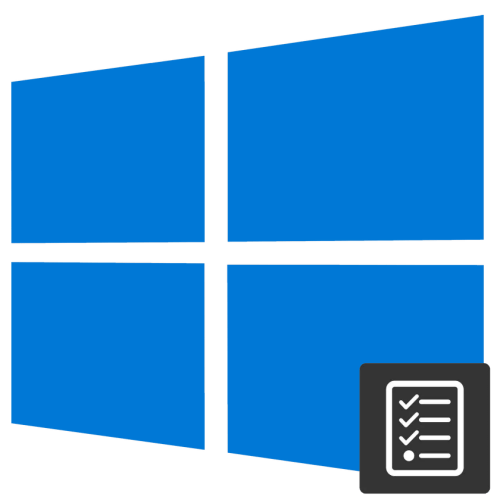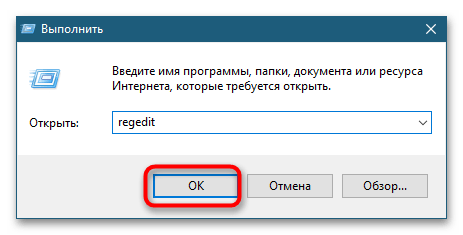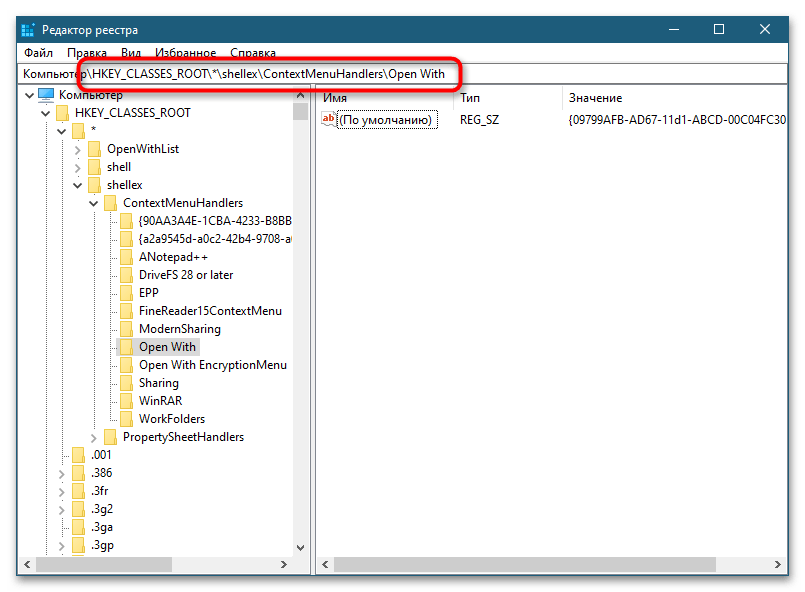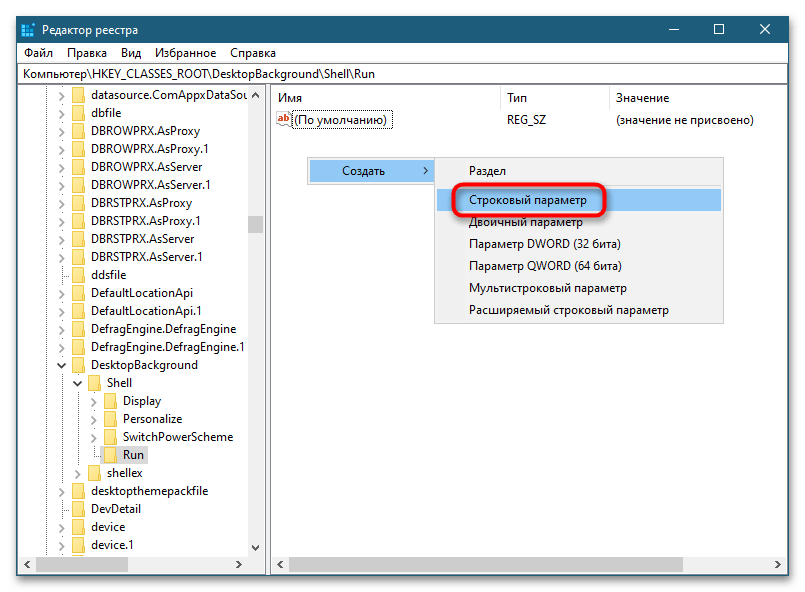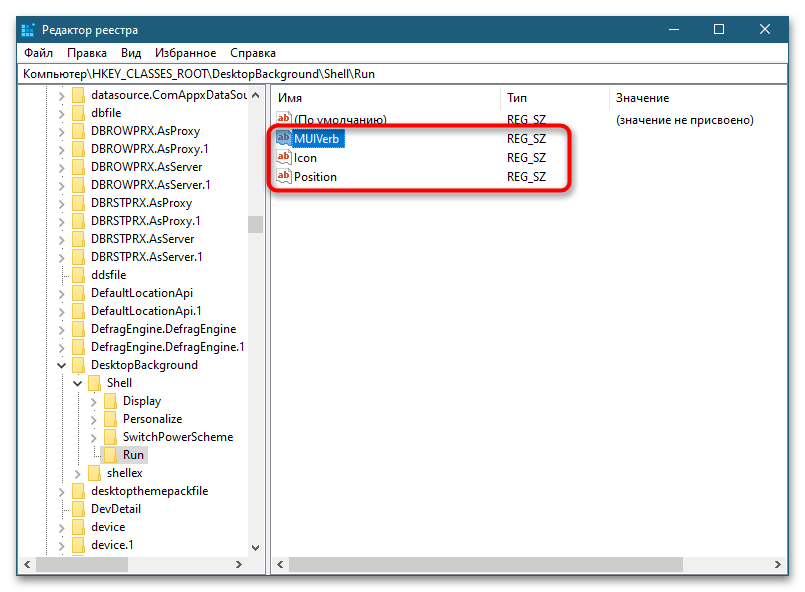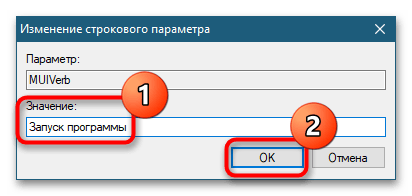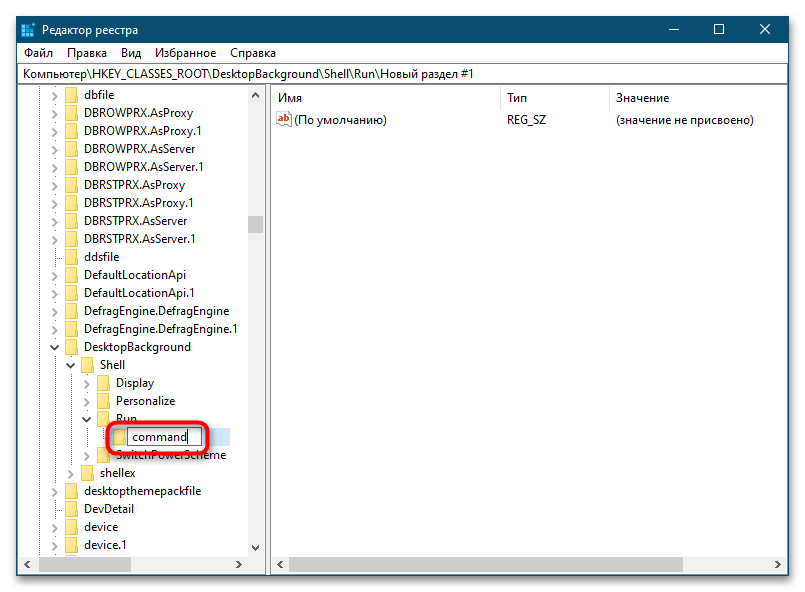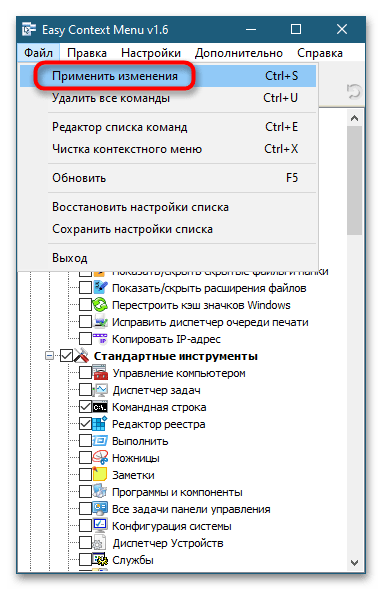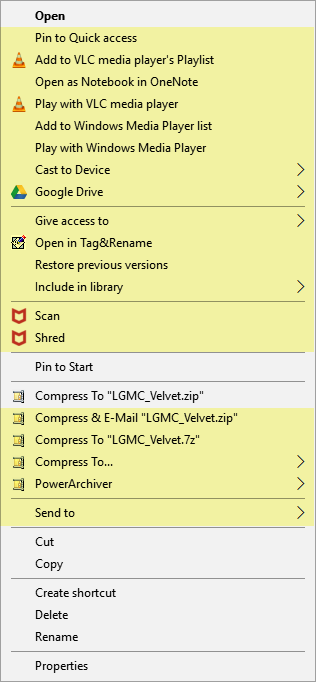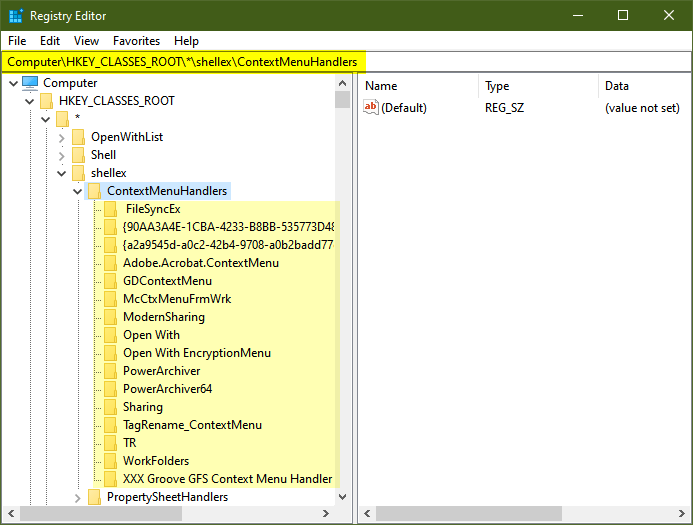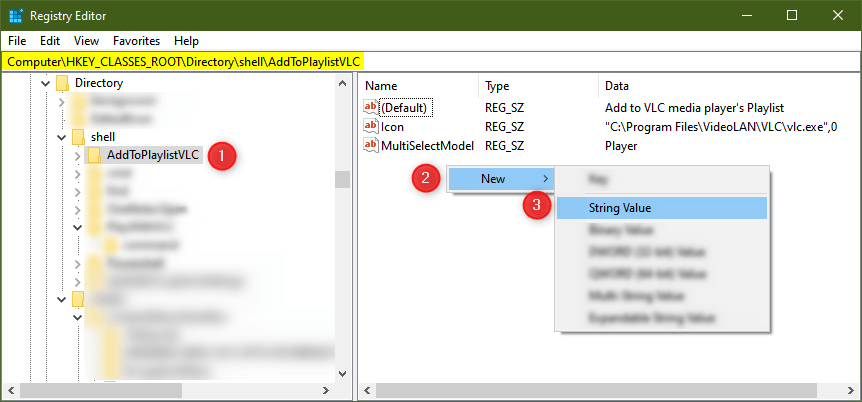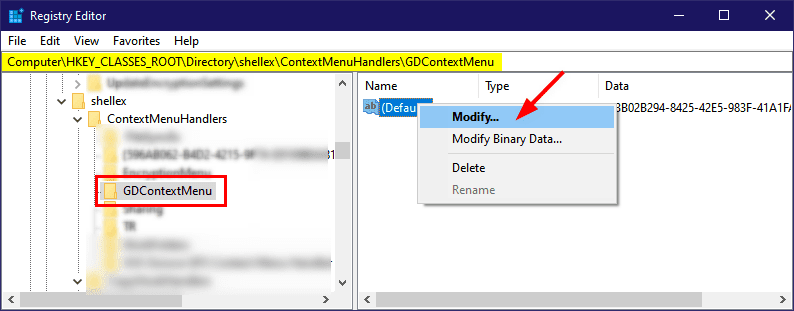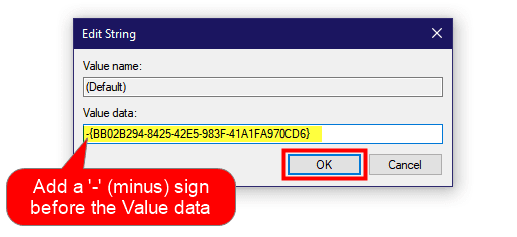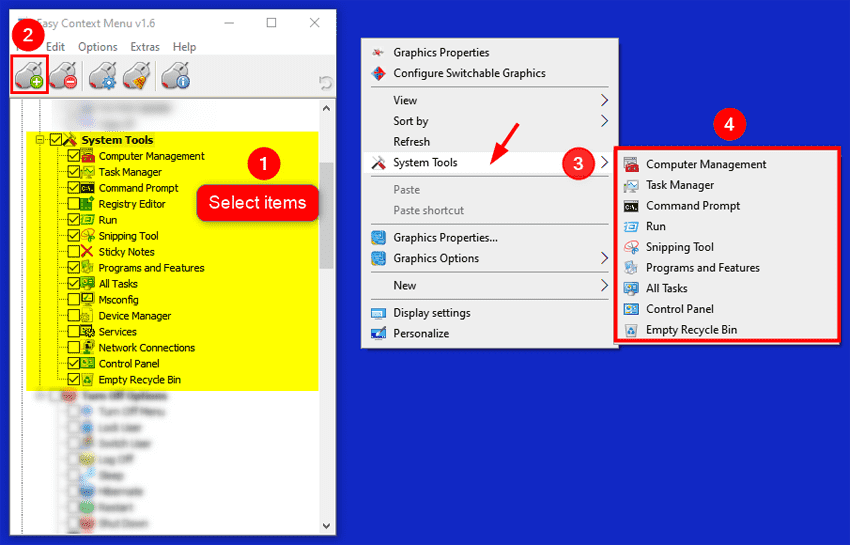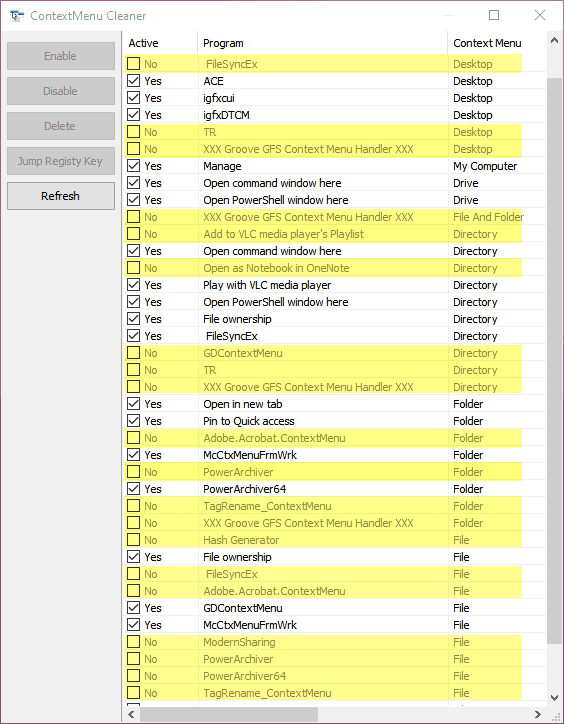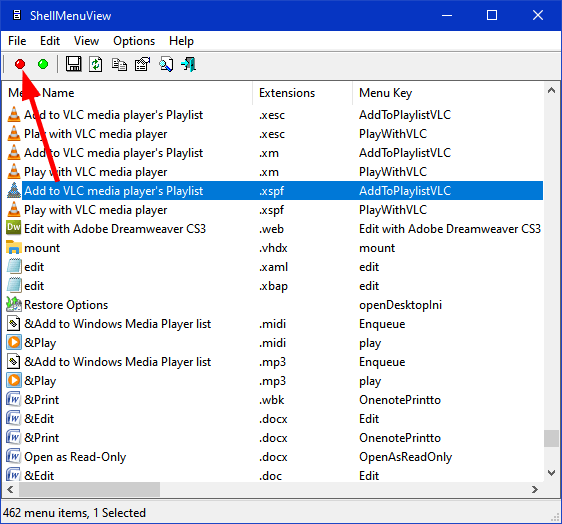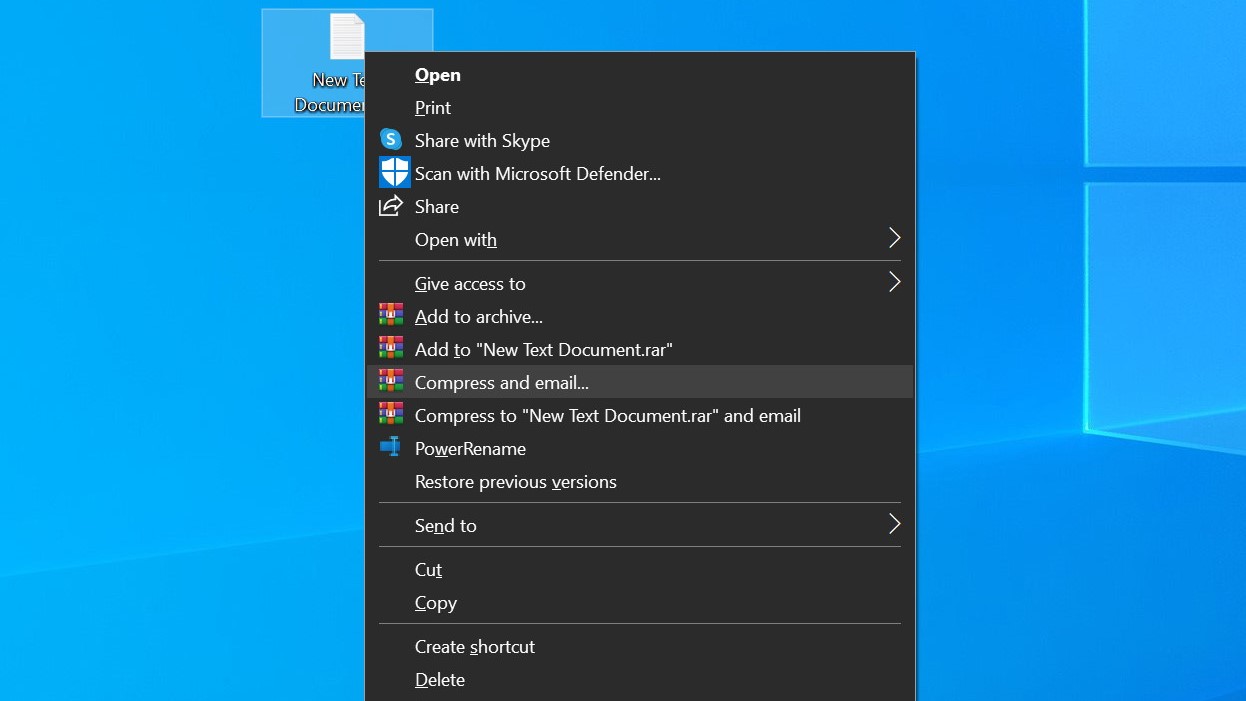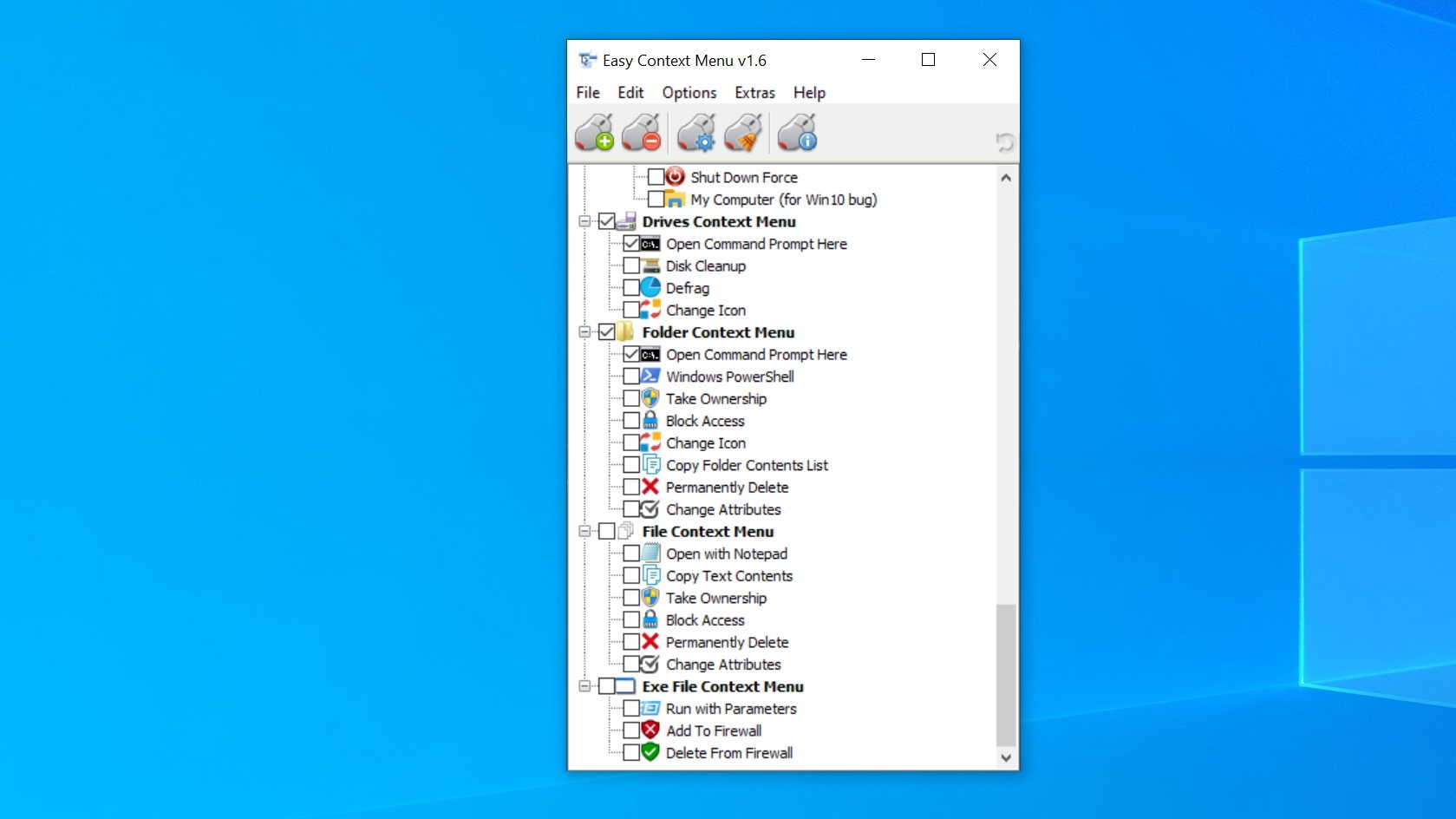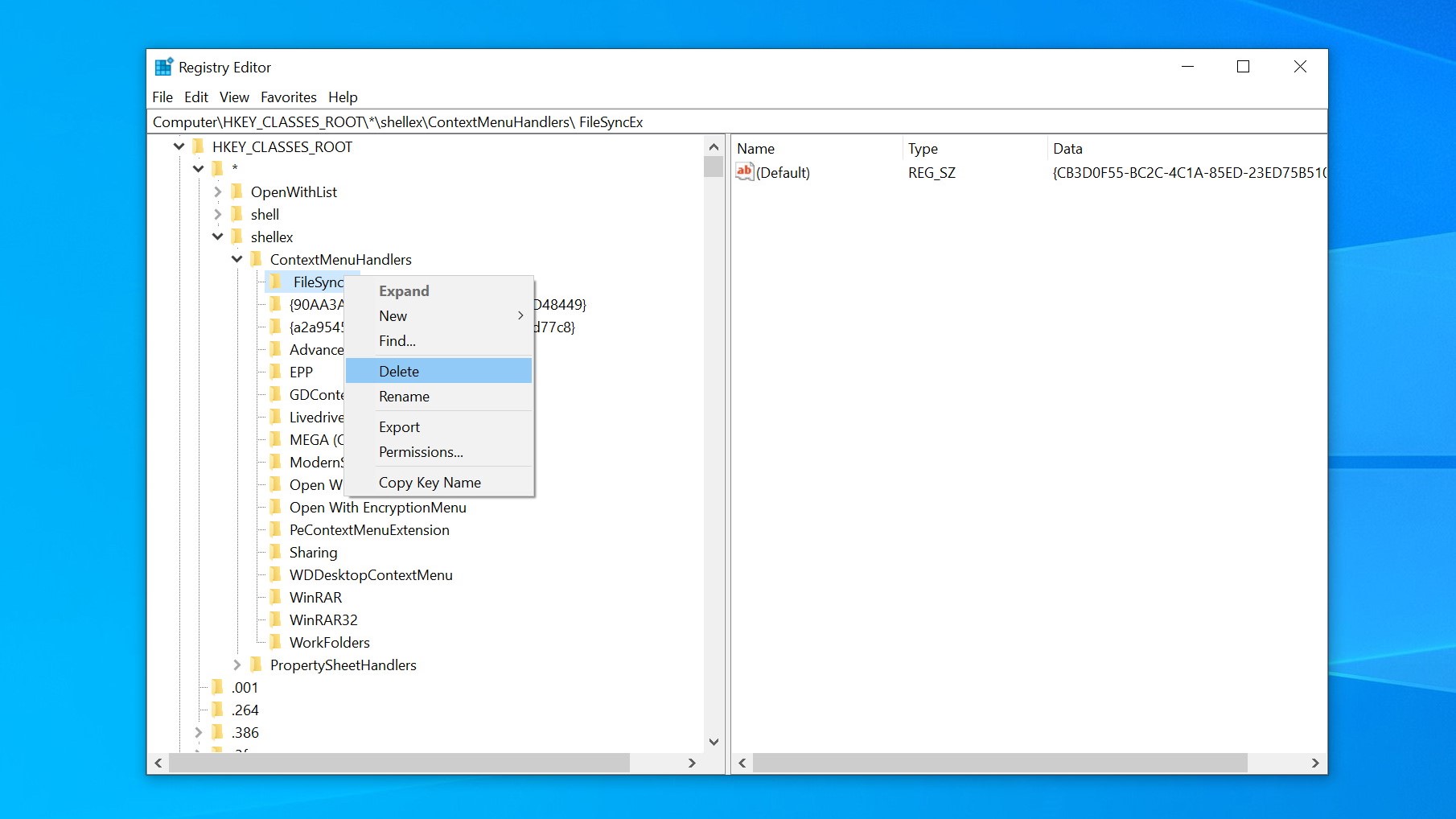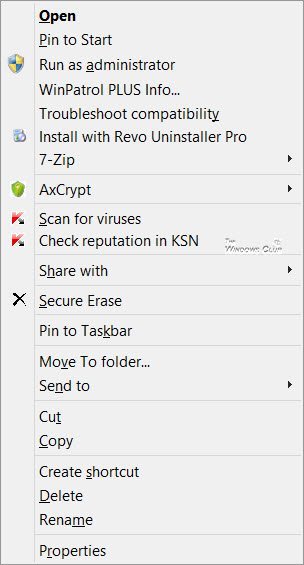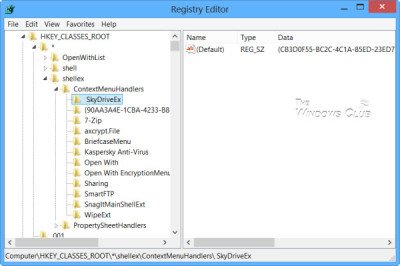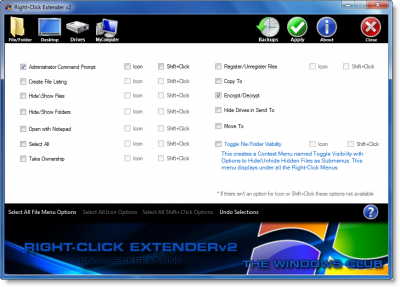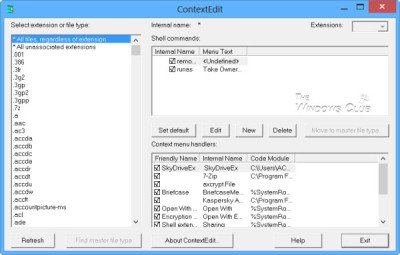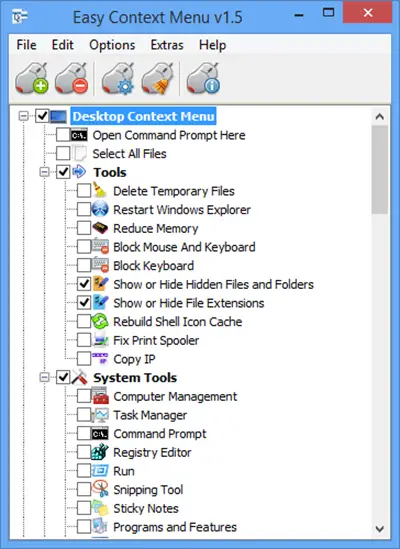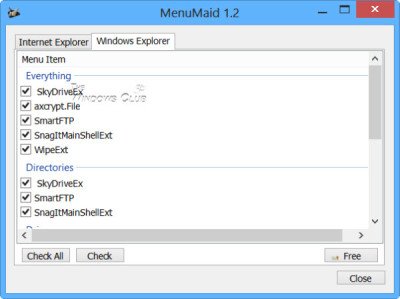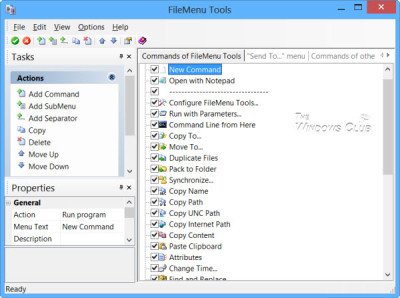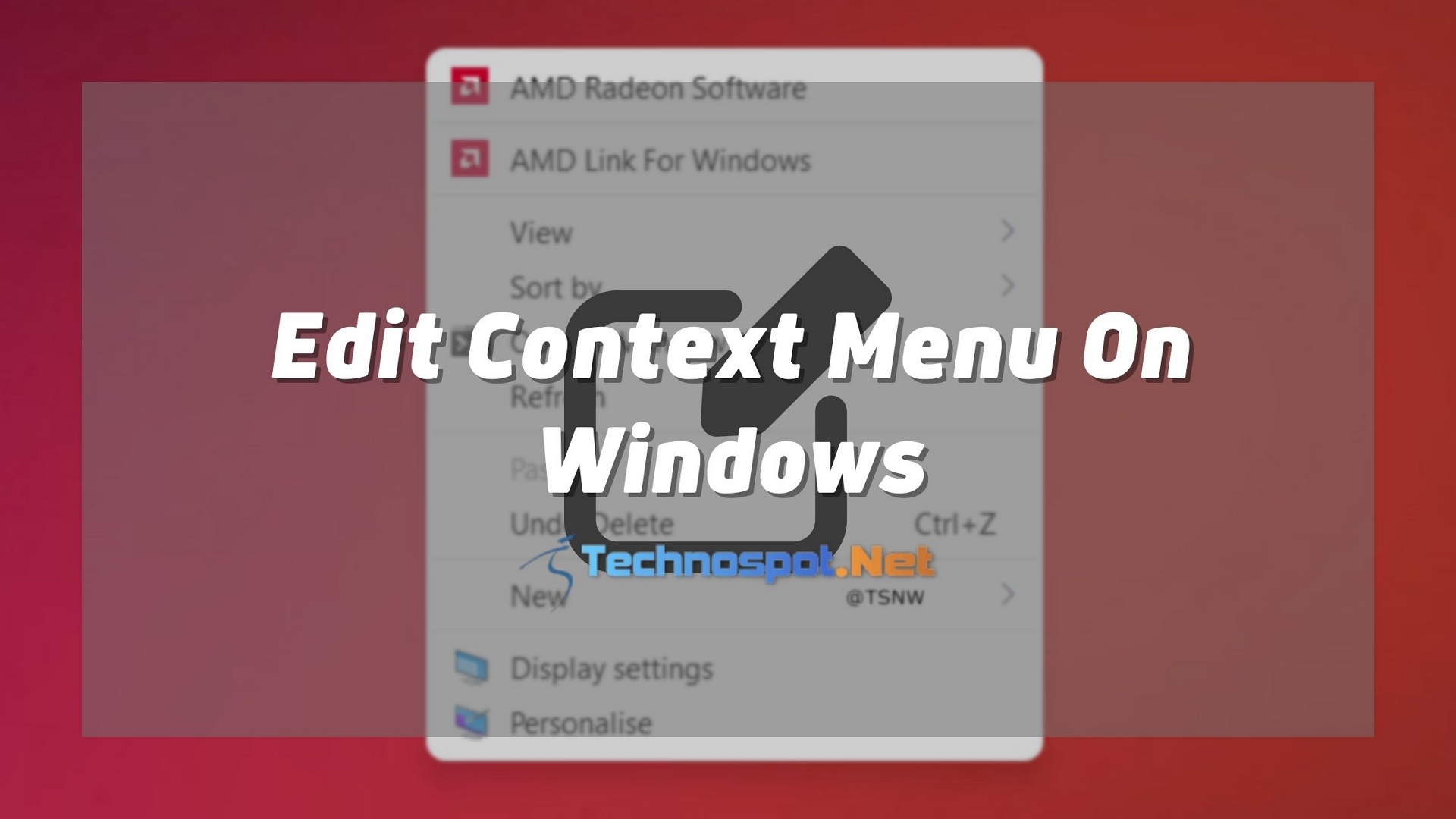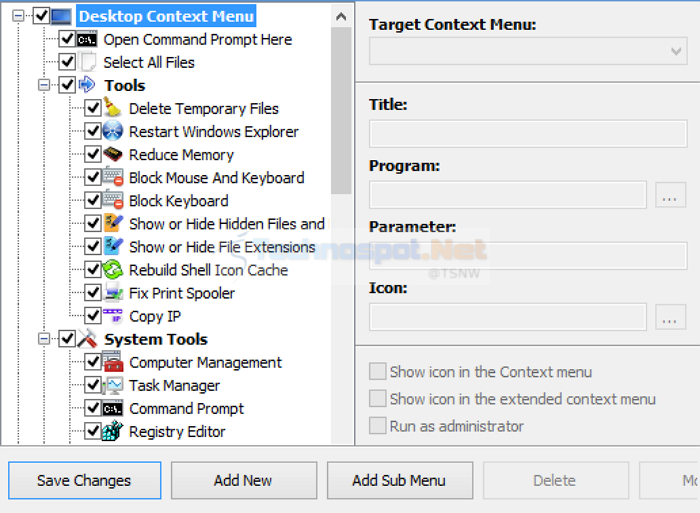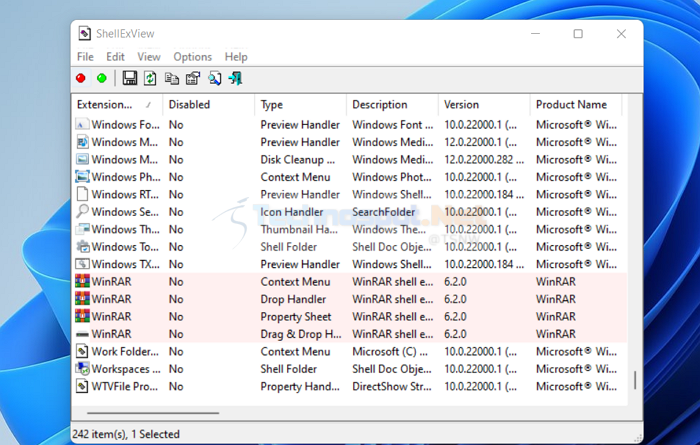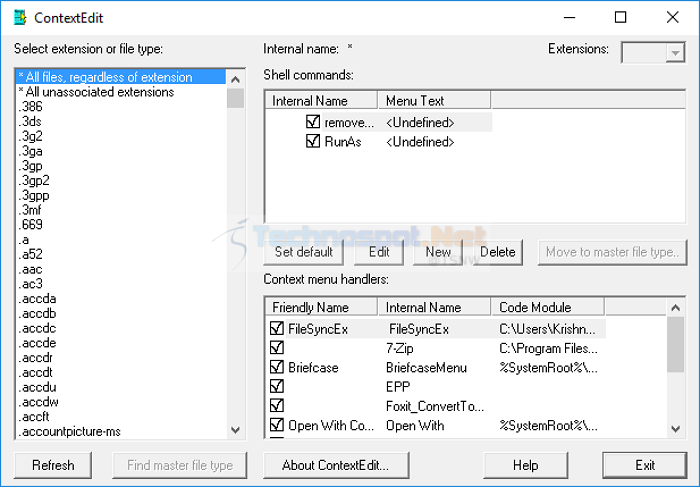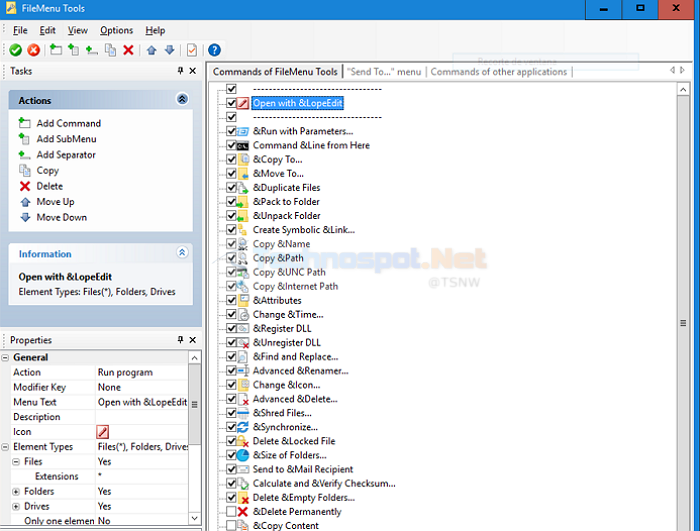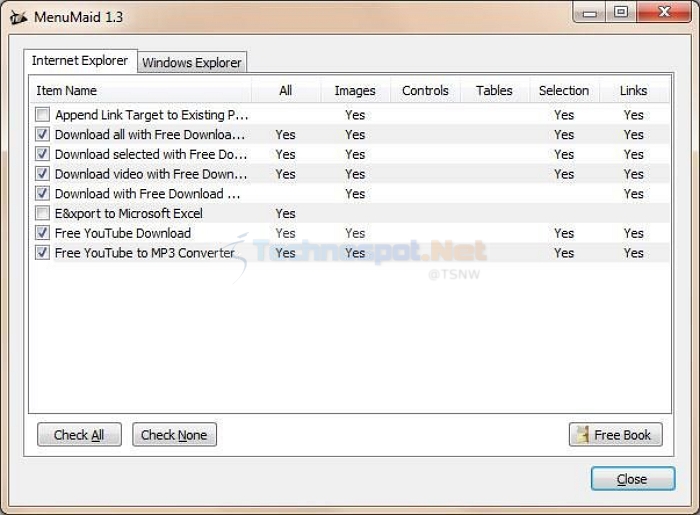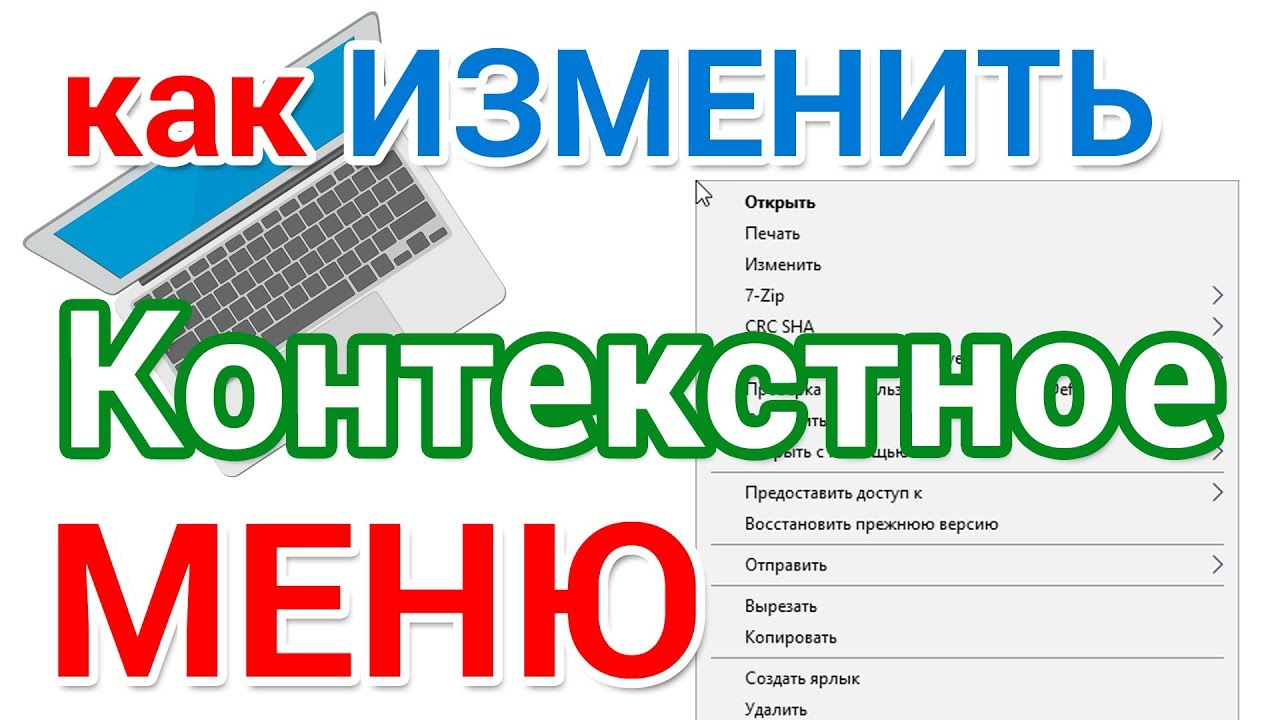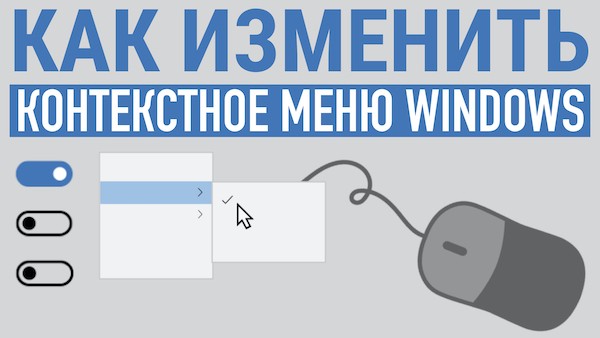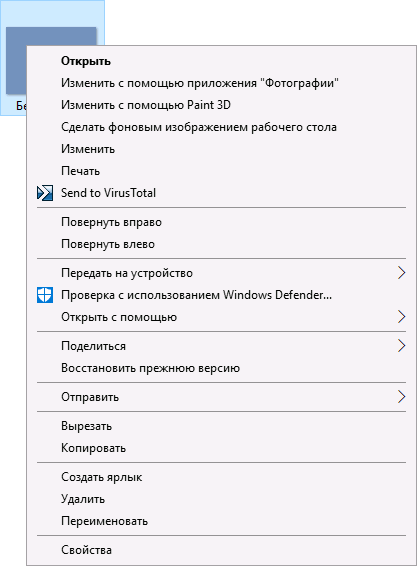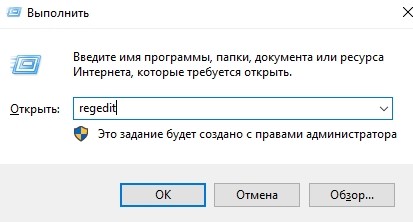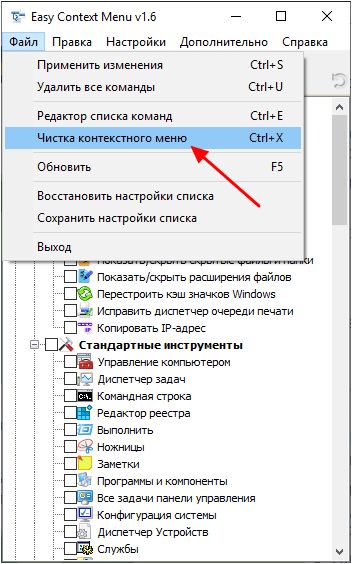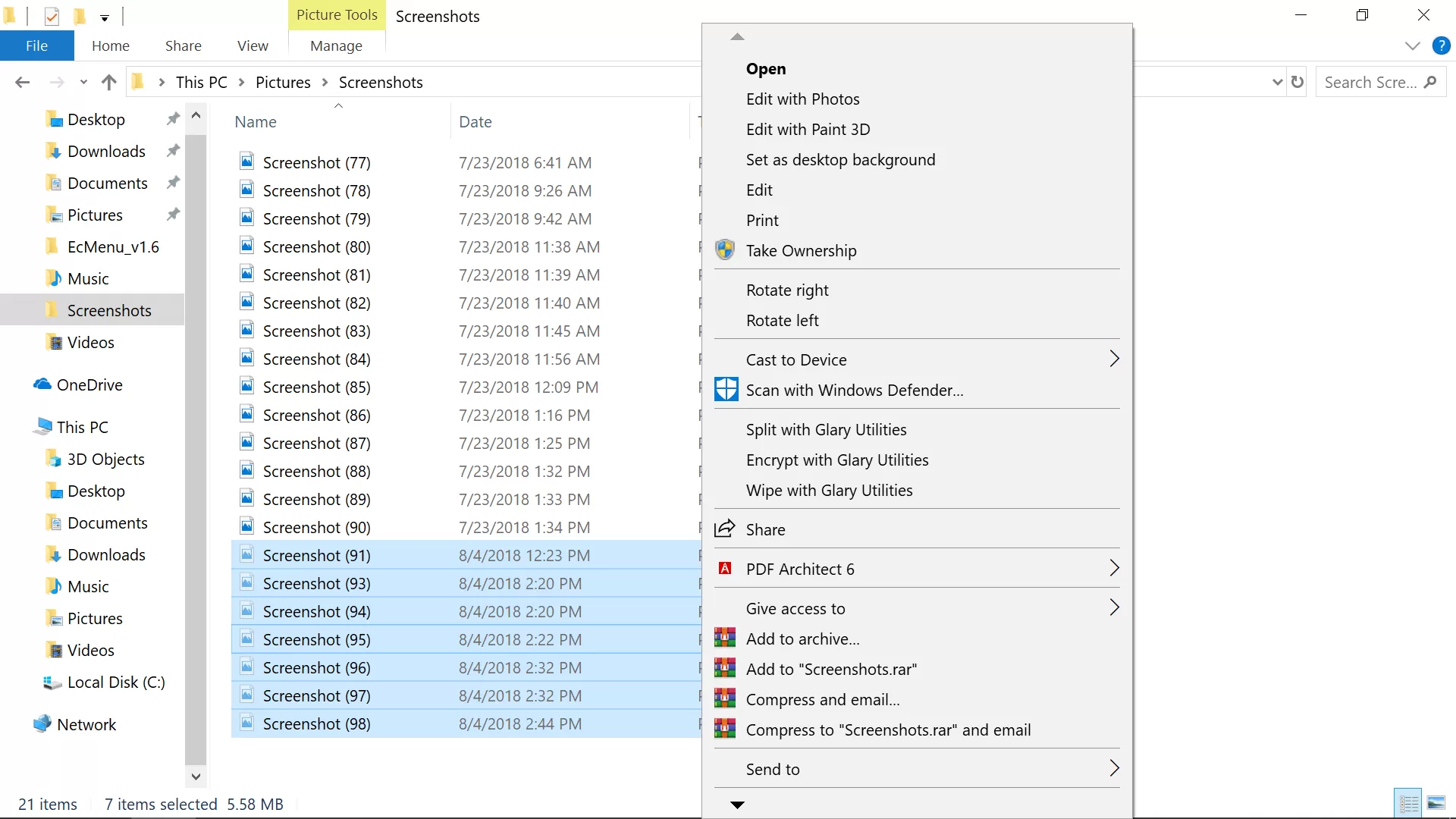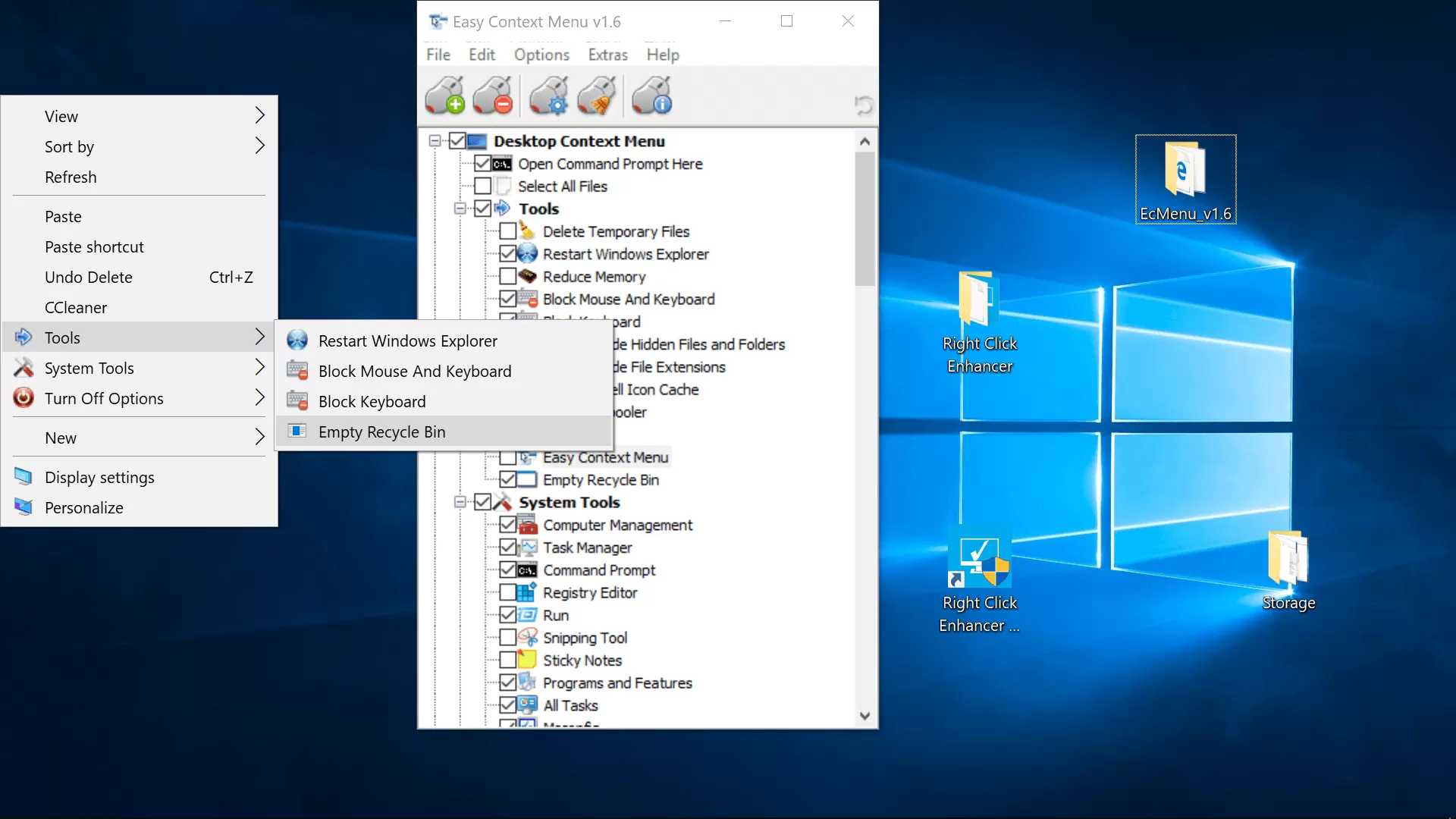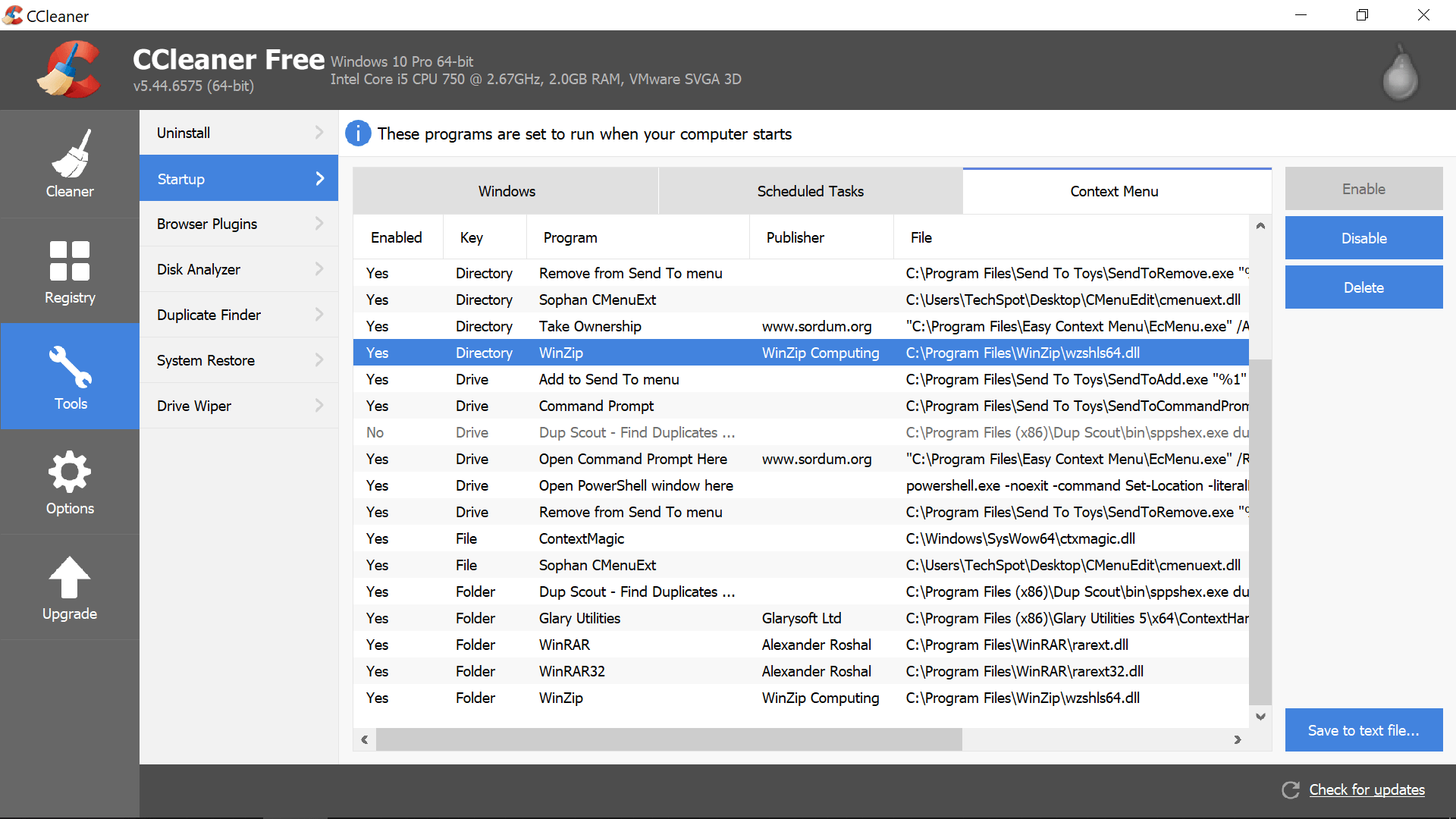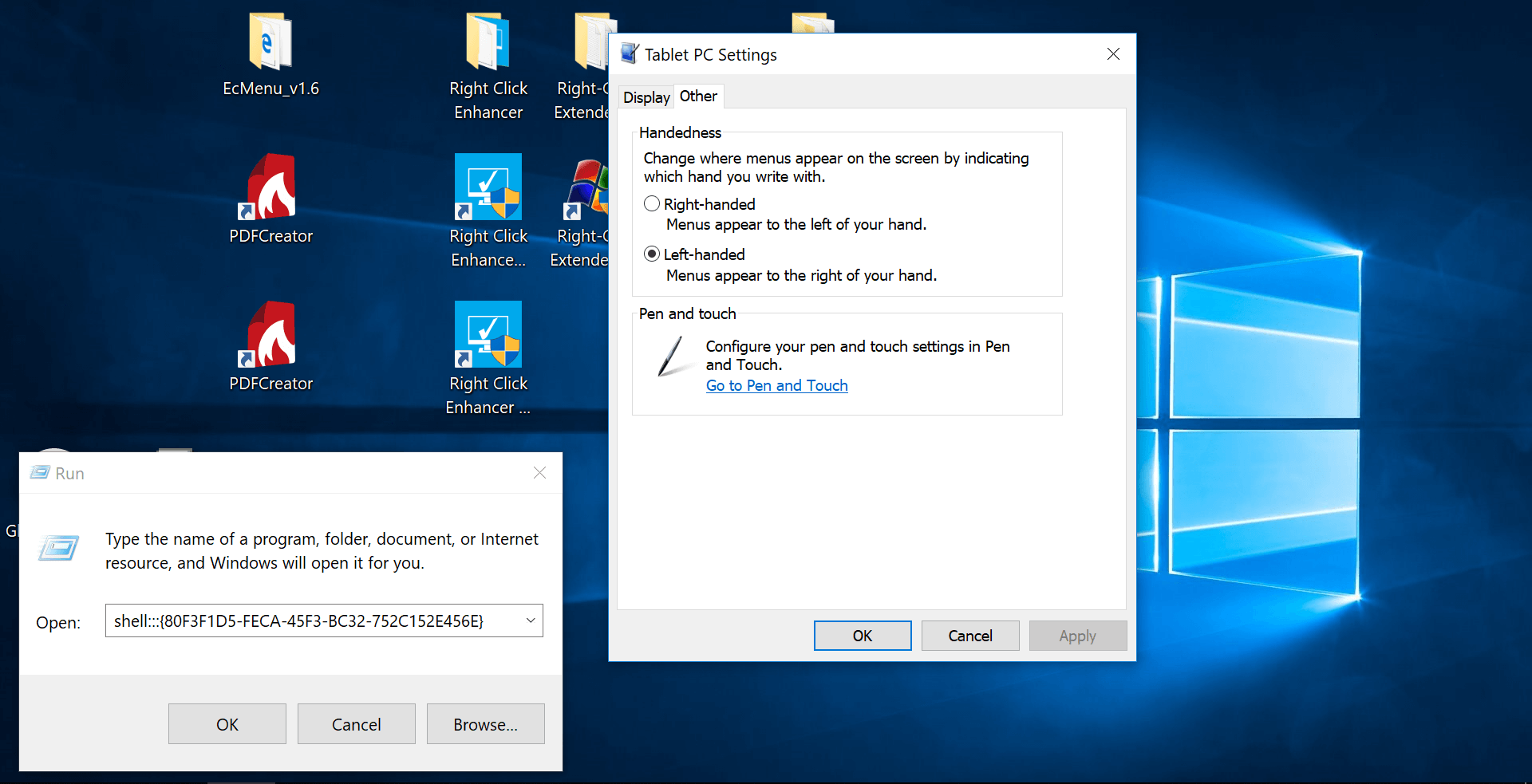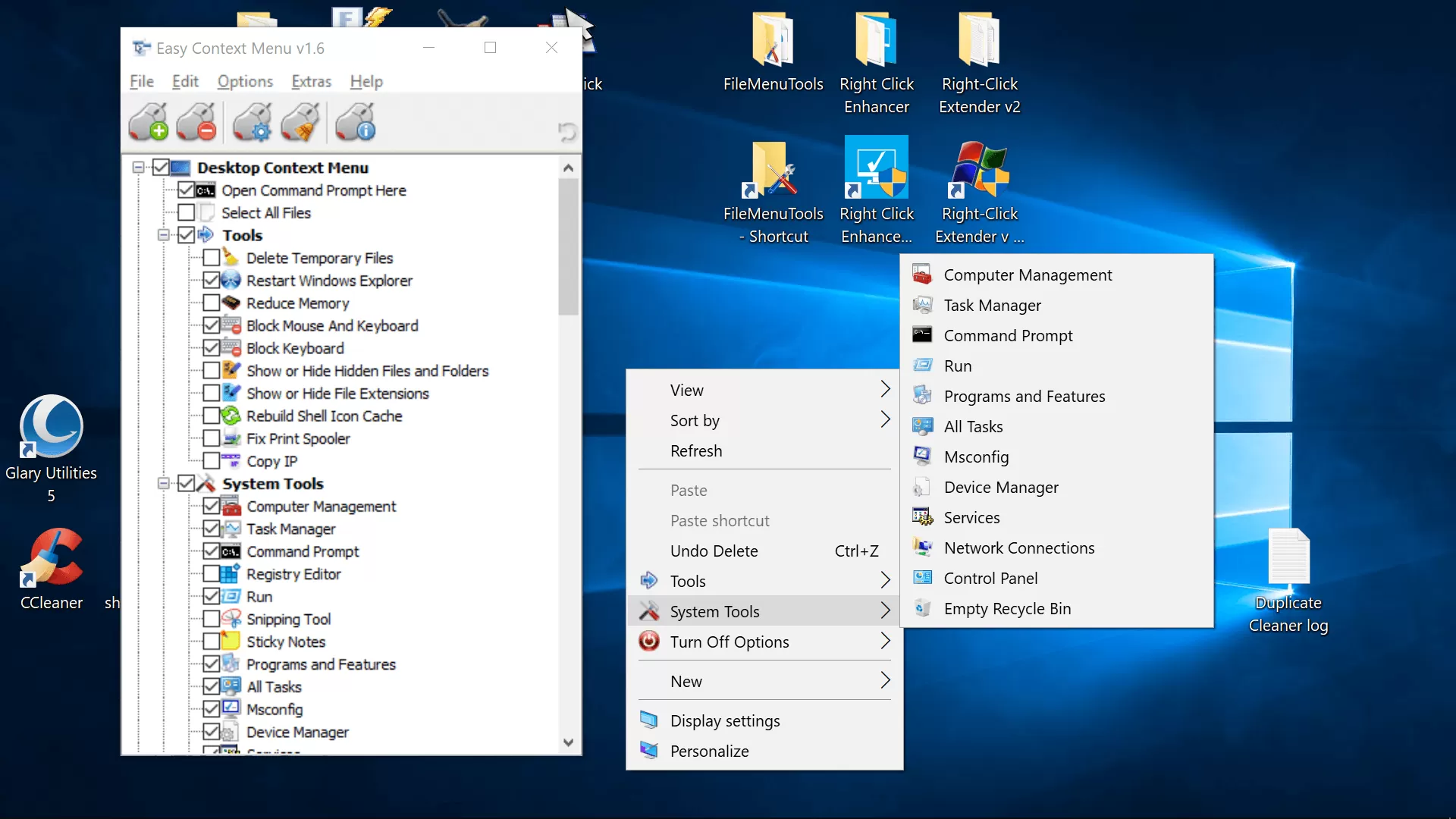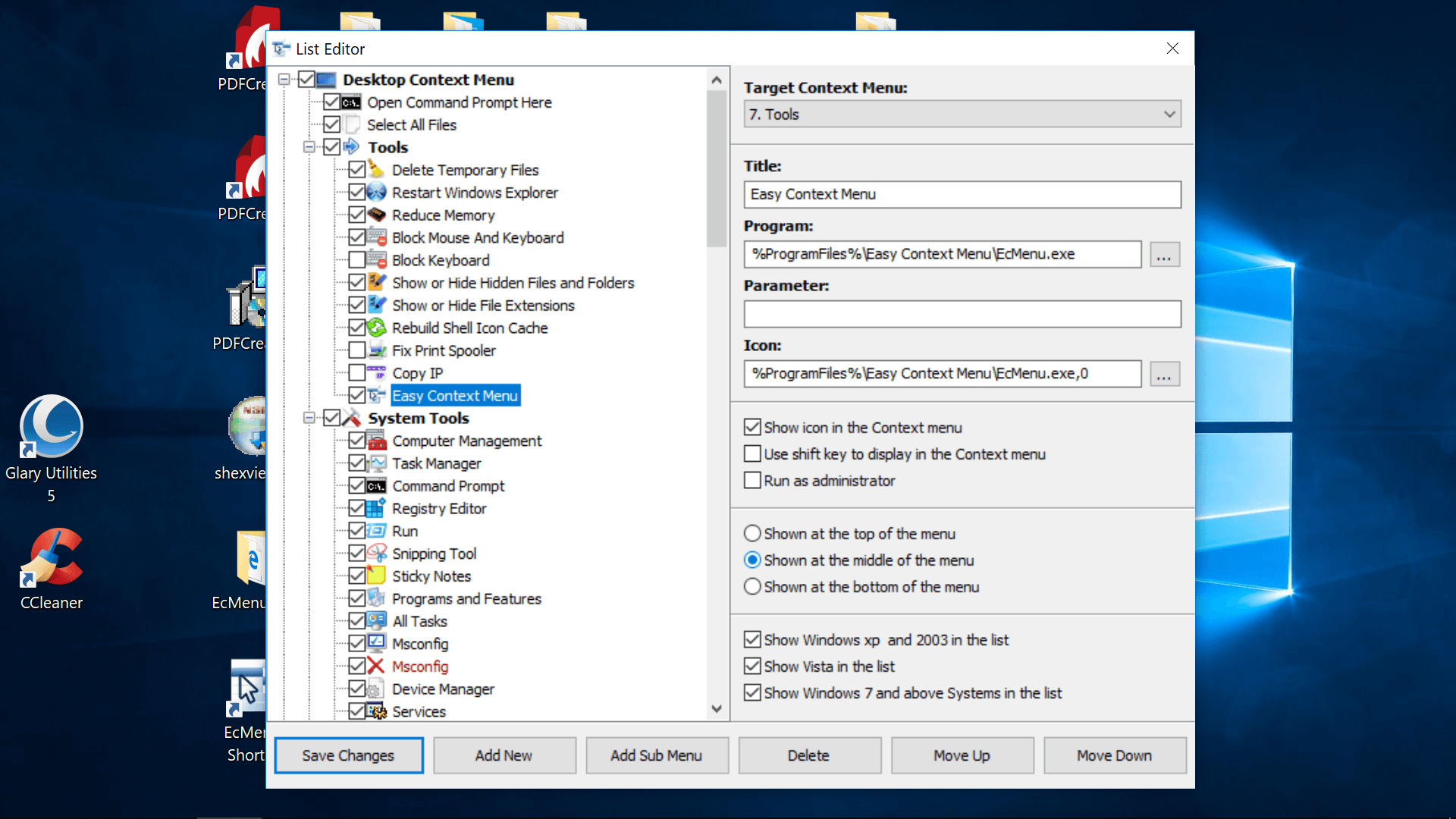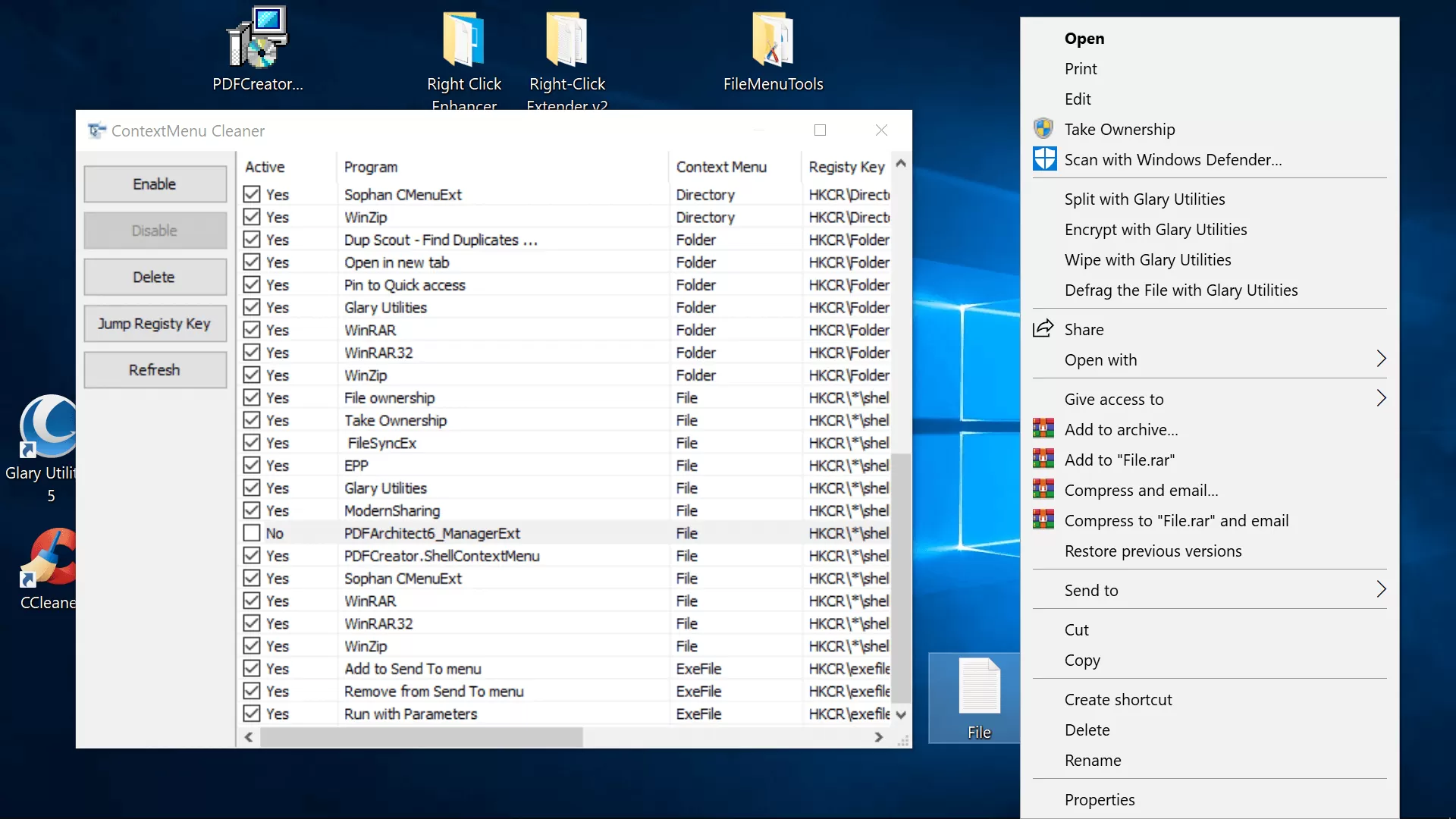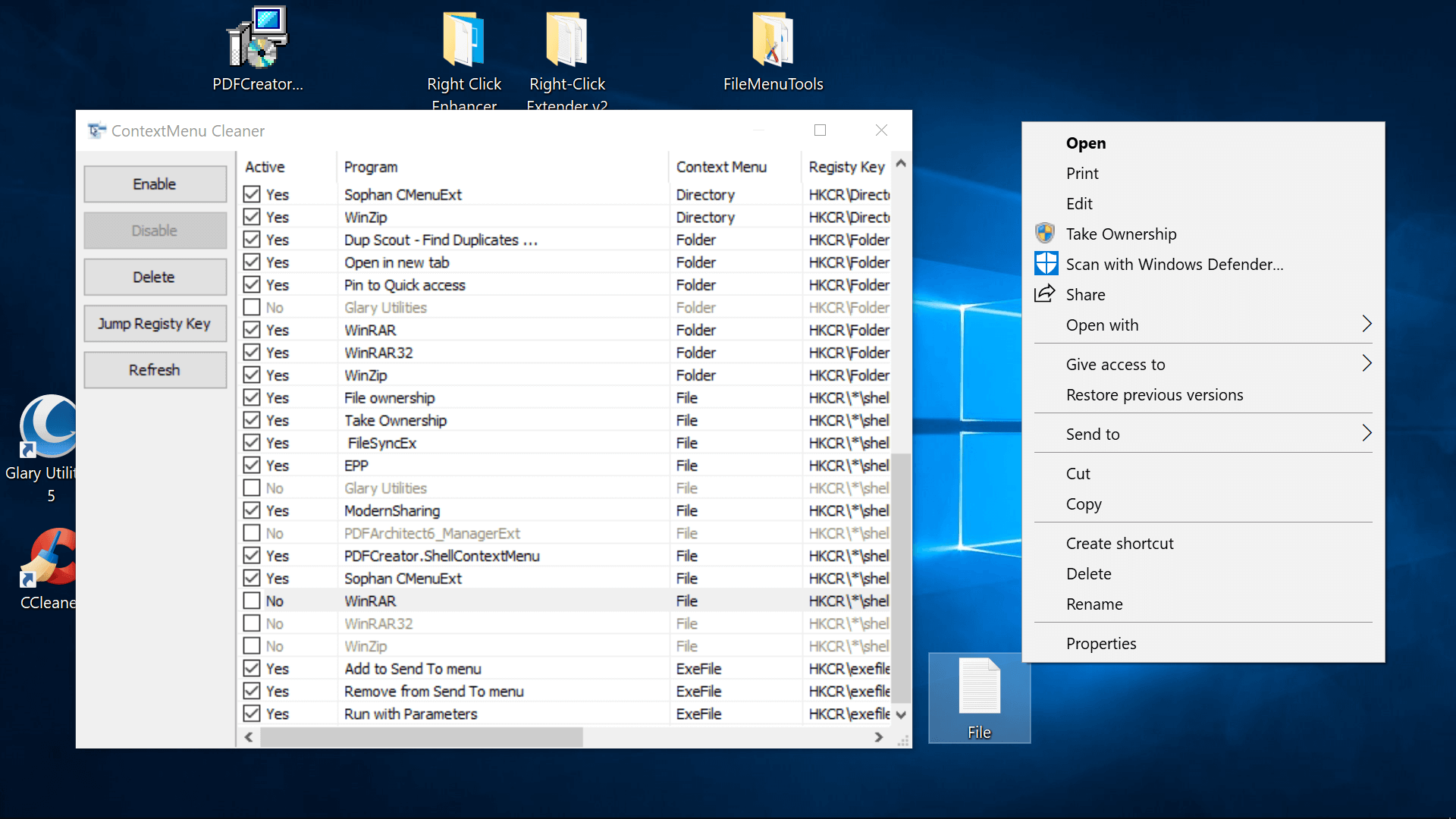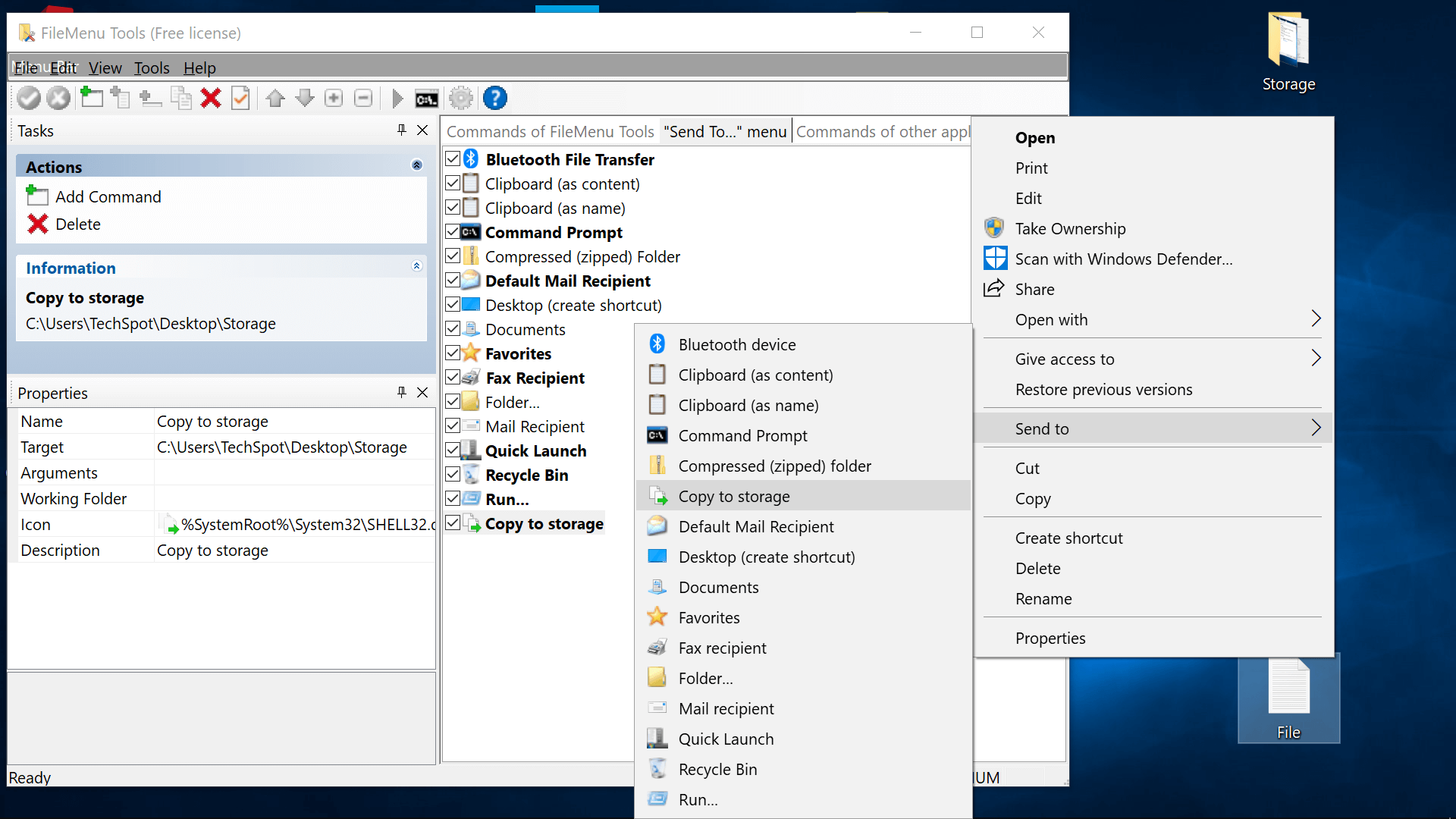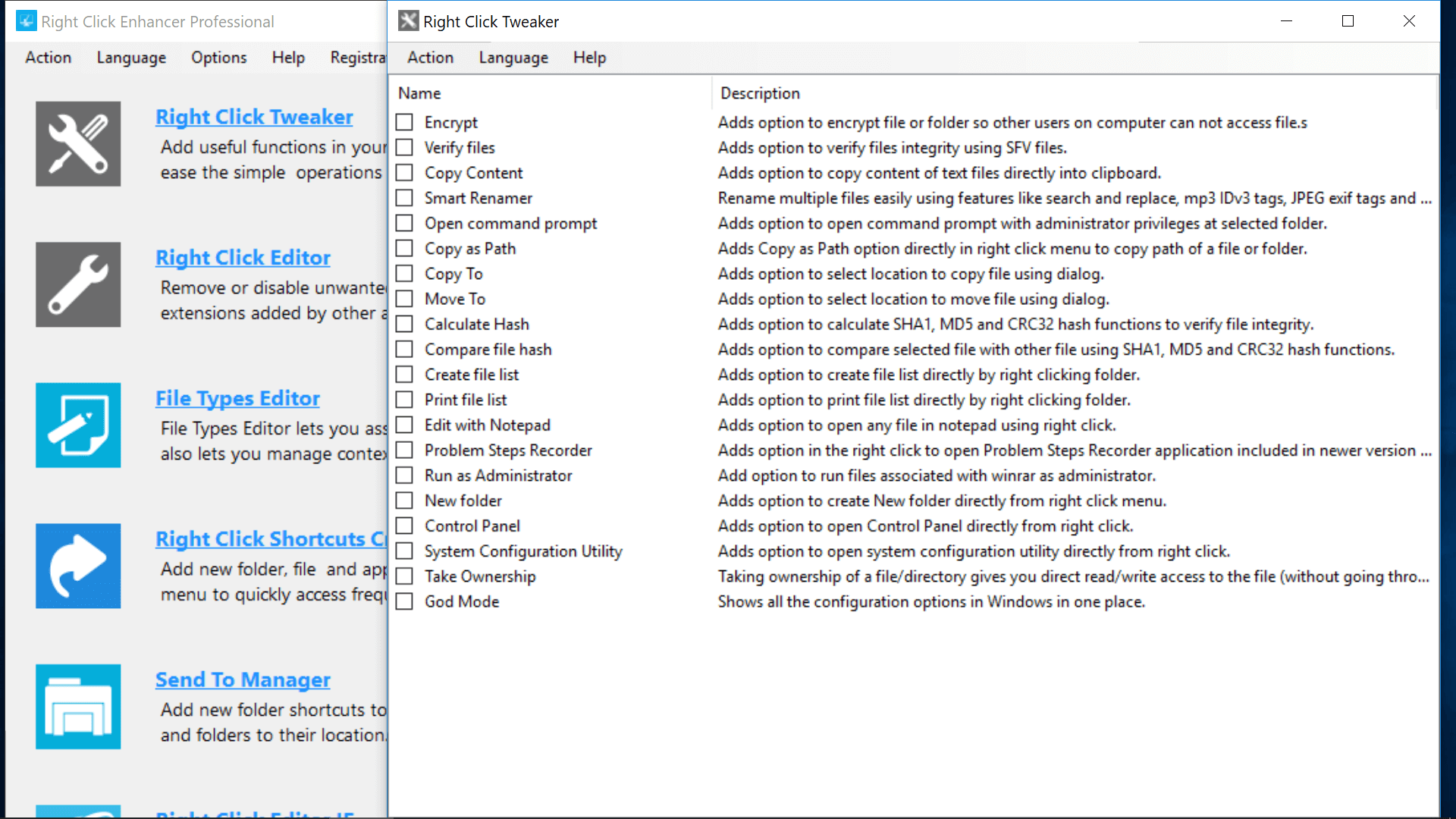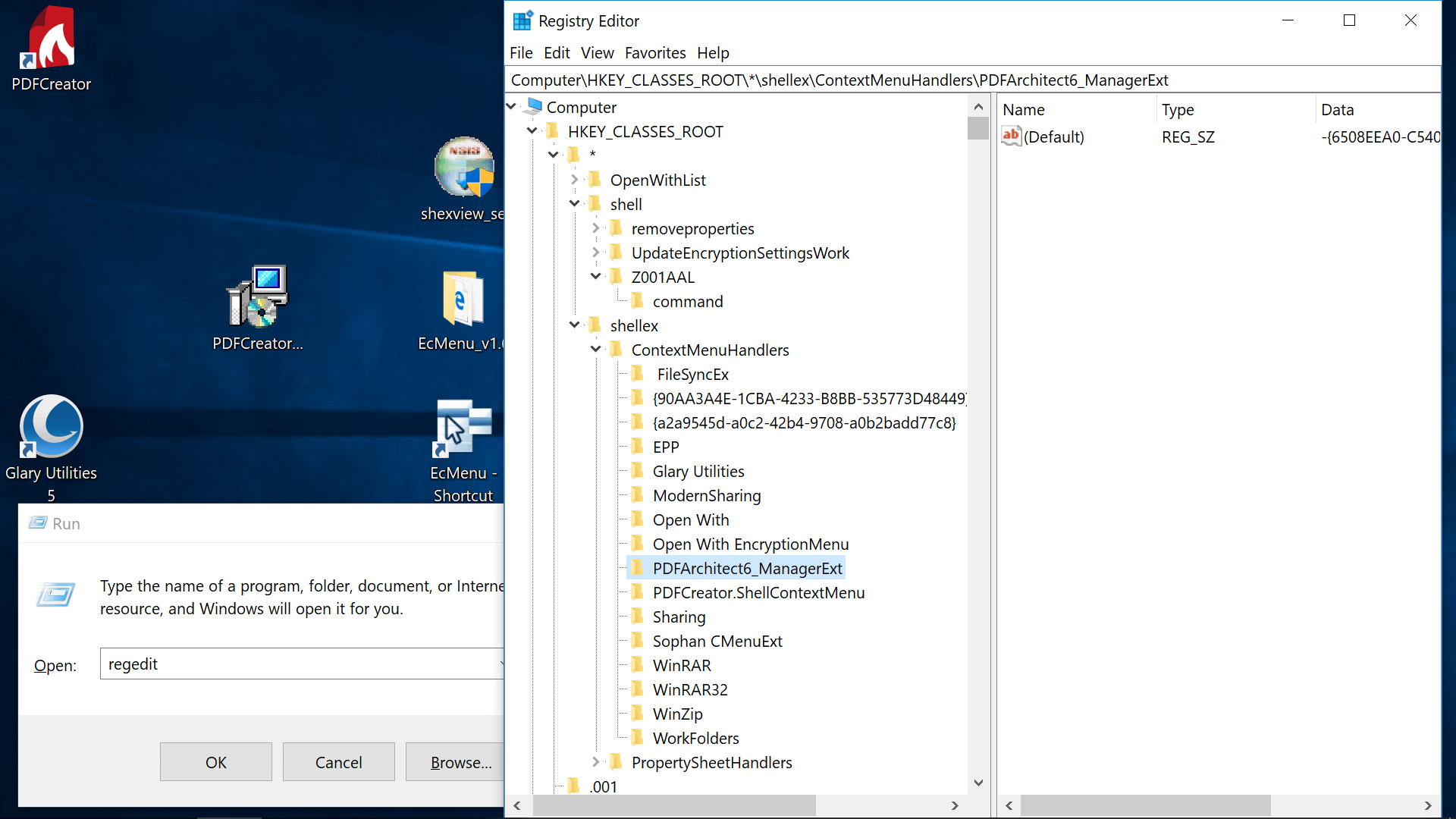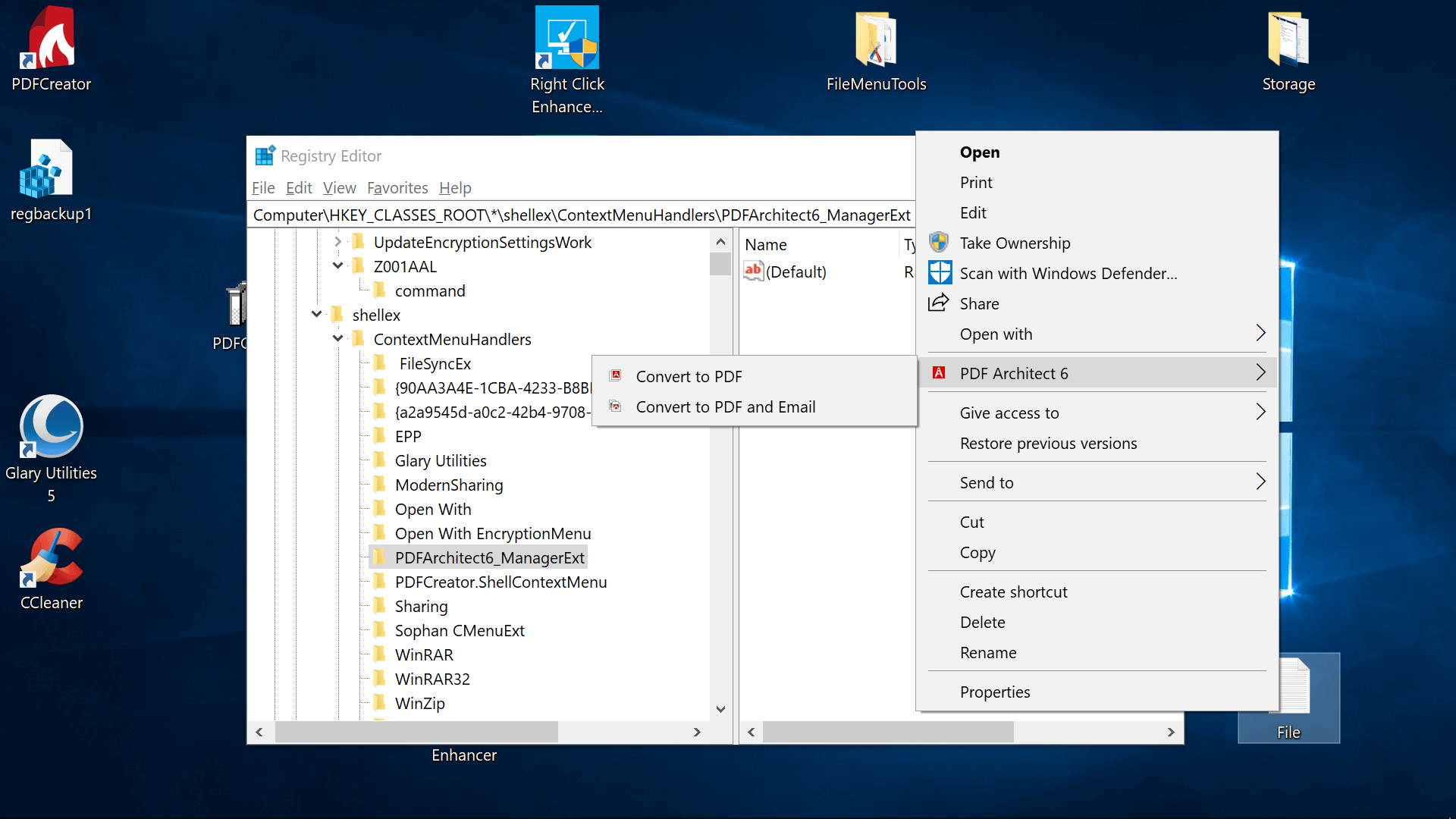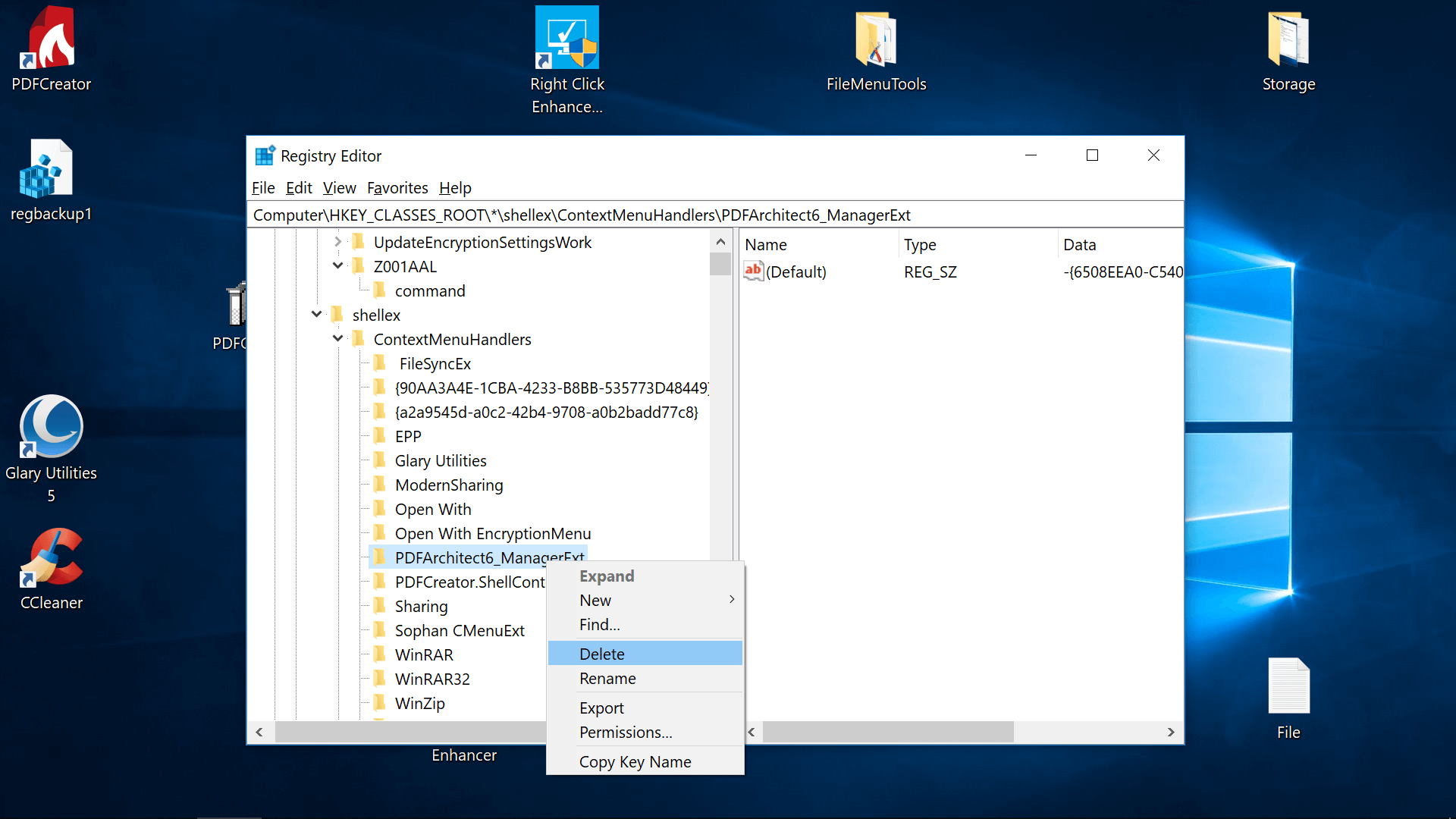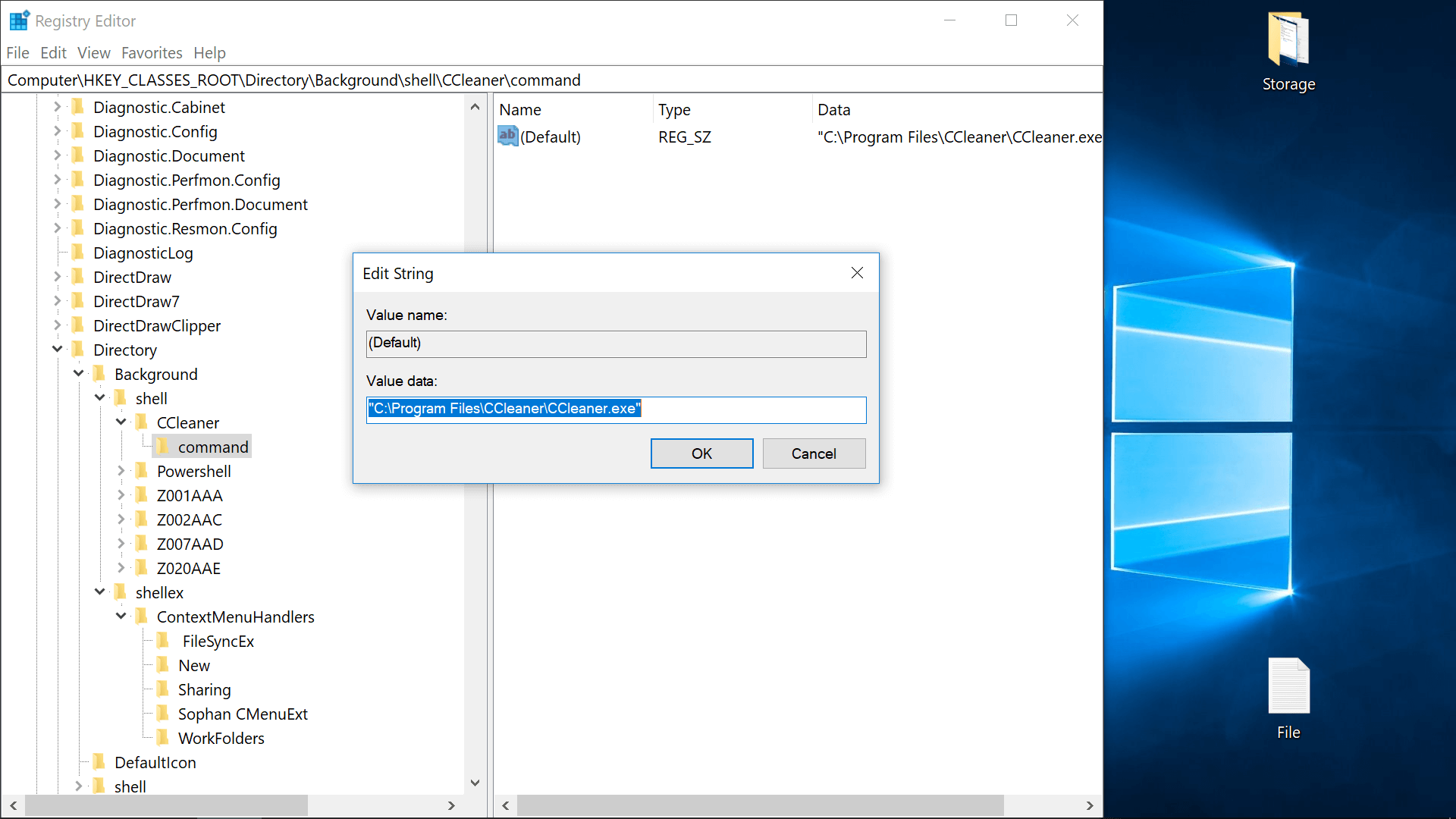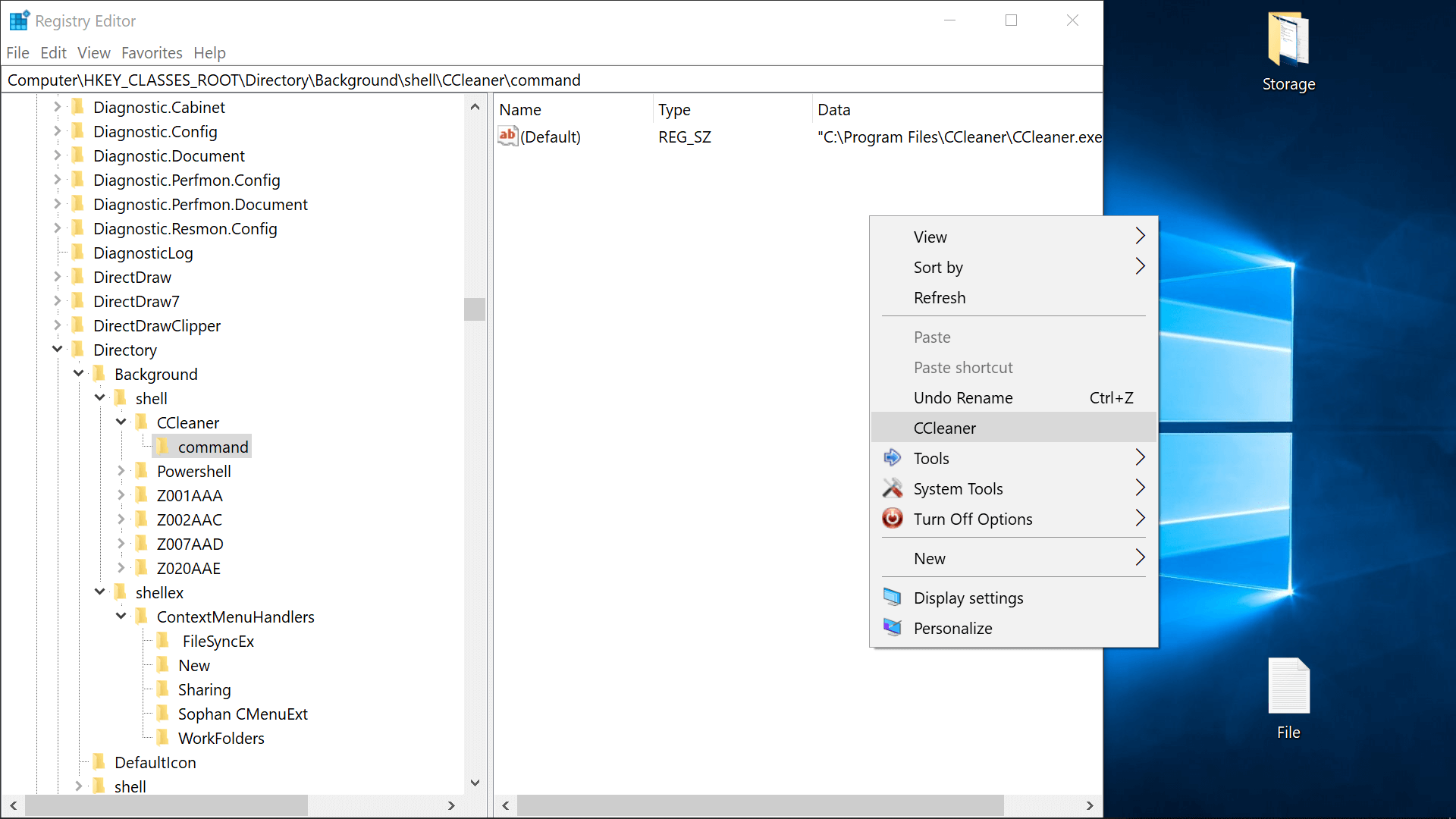Содержание
- Способ 1: Редактор реестра
- Контекстное меню для файлов
- Контекстное меню для папок
- Контекстное меню «Рабочего стола»
- Способ 2: Сторонние программы
- Easy Context Menu
- CCleaner
- Вопросы и ответы
Способ 1: Редактор реестра
За отображение тех или иных опций в контекстных меню Windows 10 отвечают ключи реестра, соответственно, чтобы добавить, удалить или отредактировать пункт в контекстном меню, необходимо изменить управляющий ключ в системном реестре.
Контекстное меню для файлов
Как правило, в большинстве случаев редактирование контекстных меню файлов и папок предполагает либо скрытие пункта, либо его переименование.
- Откройте «Редактор реестра» командой
regedit, выполненной в диалоговом окошке, вызванном комбинацией Win + R. - Разверните ветку
HKEY_CLASSES_ROOT*shellexContextMenuHandlers. В правой колонке найдите пункт, который необходимо отредактировать. Обратите внимание, что все соответствующие элементы прописаны на английском языке. К примеру, «Open With» соответствует пункту меню «Открыть с помощью». - Чтобы скрыть ненужный пункт, откройте двойным кликом окошко редактирования значения по умолчанию и переименуйте его таким образом, чтобы при желании его можно было бы легко восстановить. Например, добавьте в начало значения параметра знак «-». Более жестким вариантом является удаление подраздела, соответствующего пункту меню.
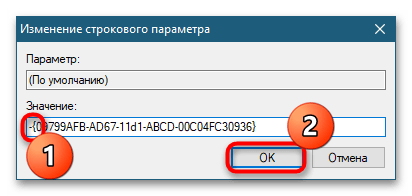
Настройки должны вступить в силу немедленно, в отдельных случаях может потребоваться перезагрузка компьютера.
Контекстное меню для папок
Похожим образом редактируется контекстное меню каталогов. Для скрытия ставшего ненужным пункта выполните такие действия.
- Откройте «Редактор реестра» и проверьте содержимое следующих веток:
HKEY_CLASSES_ROOTDirectoryshellHKEY_CLASSES_ROOTDirectoryshellexContextMenuHandlersHKEY_CLASSES_ROOTFoldershellHKEY_CLASSES_ROOTFoldershellexContextMenuHandlers
- Выберите соответствующий названию пункта меню подраздел ключа и отредактируйте значение по умолчанию, как было показано выше, либо удалите подраздел целиком.
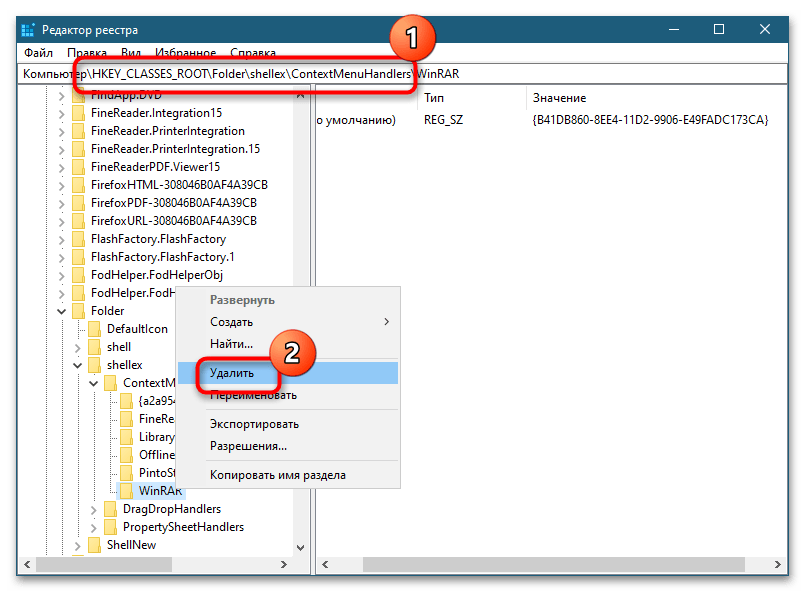
Контекстное меню «Рабочего стола»
Путем применения твиков реестра также можно редактировать контекстное меню «Рабочего стола». В большинстве случаев такая необходимость возникает, когда какая-то сторонняя программа добавляет в меню нежелательные для пользователя записи.
- Запустив «Редактор реестра», разверните ветку
HKEY_CLASSES_ROOTDesktopBackgroundShell. Последний подраздел может содержать несколько вложенных каталогов, в том числе созданных прописавшимися в контекстное меню «Рабочего стола» сторонними программами. Как правило, название таких каталогов соответствует названию создавшей их программы. - Чтобы убрать из меню добавленный сторонней программой пункт, удалите соответствующий ей подраздел в указанном ключе реестра.
- Подтвердите действие в диалоговом окошке.
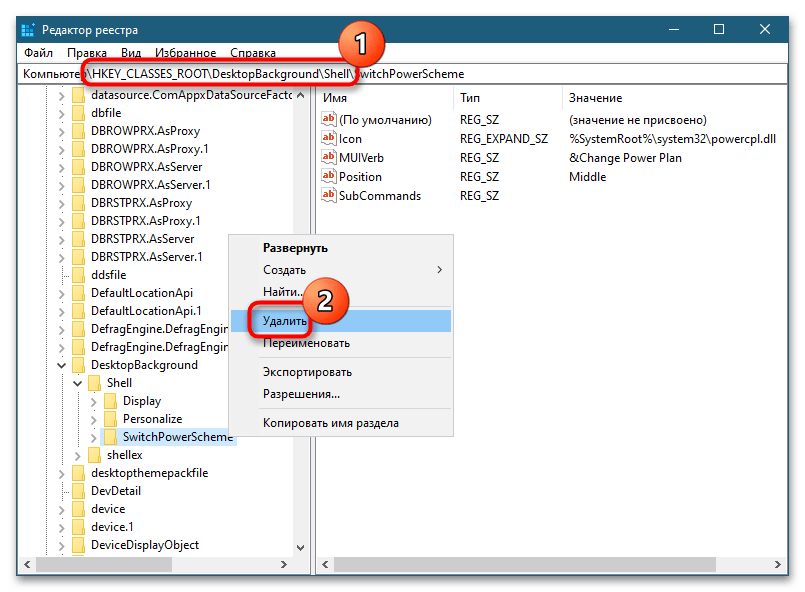

Помимо удаления ненужных пунктов контекстного меню «Рабочего стола», можно добавлять в него собственные пункты, например для быстрого запуска избранных программ.
- Открыв «Редактор реестра», разверните ветку
HKEY_CLASSES_ROOTDesktopBackgroundShell, кликните правой кнопкой мыши по пустой области справа и выберите «Создать» → «Раздел». Название создаваемого раздела может быть произвольное, желательно на английском языке. - Точно так же вызовите контекстное меню уже в созданном разделе и выберите «Создать» → «Строковый параметр».
- Создайте строковые параметры «MUIVerb», «Icon», «Position».
- Откройте двойным кликом по параметру «MUIVerb» окошко редактирования его значения и впишите в него название пункта меню. Оно может быть как английское, так и кириллическое.
- Остальные параметры являются необязательными. «Icon» позволяет выбрать иконку для пункта меню, «Position» же задает место расположения пункта в меню. Далее в текущем подразделе необходимо создать дочерний подраздел и назвать его «command».
- Перейдите в созданный раздел, откройте двойным кликом окошко редактирования параметра по умолчанию и задайте в качестве его значения полный путь к исполняемому файлу программы или скрипта. Исключение составляют программы, исполняемые файлы которых находятся в системной папке. В этом случае можно указать только название исполняемого файла.
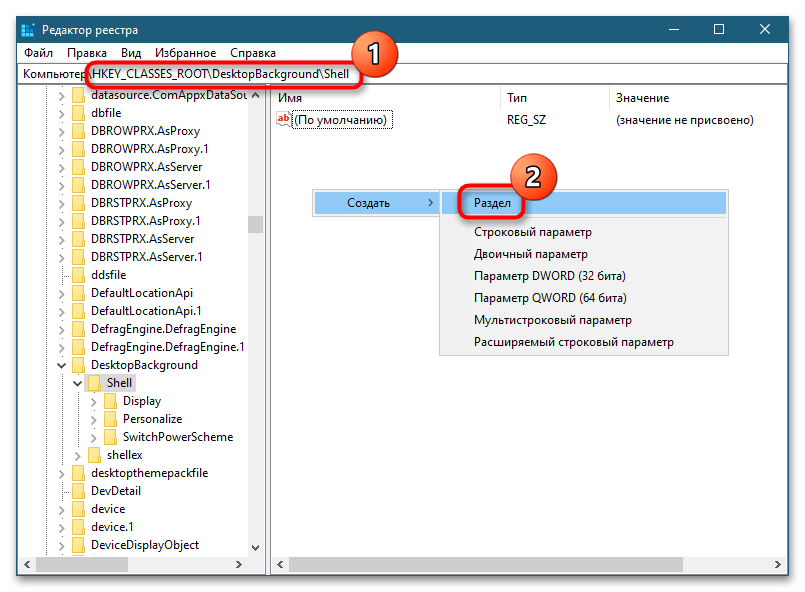
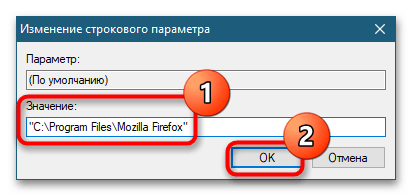
В результате описанных выше манипуляций в контекстном меню появится новый активный пункт, и таких пунктов можно создать сколько угодно.
Способ 2: Сторонние программы
Тем, кому способ редактирования контекстных меню с помощью «Редактора реестра» кажется сложным, можно порекомендовать специальные программы – редакторы контекстных меню.
Бесплатная портативная программа, предназначенная для расширения возможностей контекстных меню «Рабочего стола», «Этого компьютера», папок, дисков, исполняемых и неисполняемых файлов.
Скачать Easy Context Menu с официального сайта
- Скачайте архив с программой с сайта разработчика, распакуйте и запустите исполняемый файл EcMenu.exe.
- Выберите нужный раздел, отметьте флажками пункты, которые хотите добавить в контекстное меню.
- Выберите на вкладке «Файл» опцию «Применить изменения» или нажмите комбинацию клавиш Ctrl + S.
- Если нужно удалить нежелательный пункт, выберите на вкладке «Файл» опцию «Чистка контекстного меню».
- Выделите ненужный пункт в открывшемся списке и нажмите кнопку «Отключить» или «Удалить».
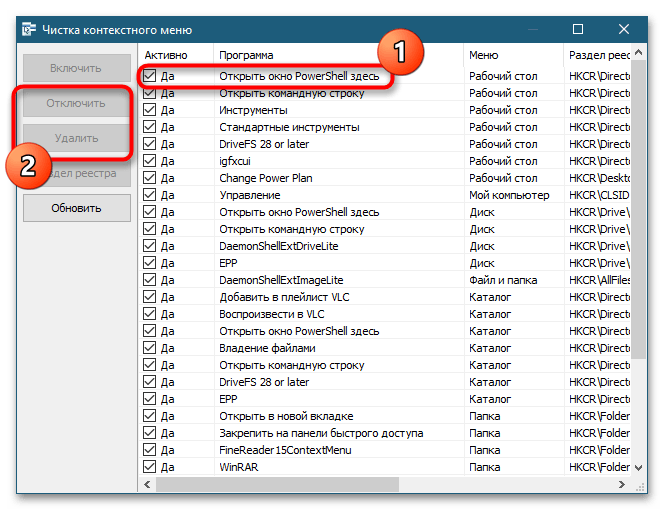
Дополнительно приложением Easy Context Menu поддерживается редактирование названий добавляемых пунктов меню, замена иконок по умолчанию, порядка расположения пунктов. Чтобы вызвать этот внутренний редактор, нажмите комбинацию клавиш Ctrl + E.
CCleaner
Если Easy Context Menu предназначена в основном для добавления в контекстные меню новых элементов, то для удаления ставших ненужными элементов контекстных меню вполне подойдет популярный чистильщик CCleaner.
Скачать CCleaner
- Скачайте программу с сайта разработчика, установите и запустите.
- Зайдите в раздел «Инструменты» → «Запуск» и переключитесь на вкладку «Контекстное меню».
- Выделите ненужный элемент контекстного меню мышкой и нажмите «Выключить» или «Удалить», если хотите избавиться от пункта навсегда.
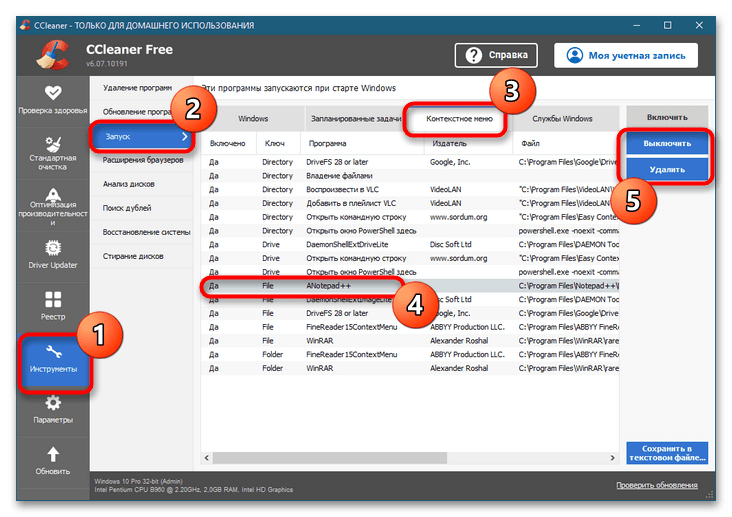
Существуют также и другие программные средства редактирования контекстных меню Windows 10, но в большинстве случаев пользователям хватает возможностей описанных выше инструментов.
Еще статьи по данной теме:
Помогла ли Вам статья?
While the right-click context menu on Windows 10 is very handy as it lets us access the quick actions contextually. Some programs add more items to the context menu and make it cluttered. Fortunately, it’s easy to remove or add a program and edit the right-click context menu on Windows 10 via the Registry editor and context menu customizer programs like Nirsoft ShellMenuView, Easy Context Menu, Context Menu Tuner, and CCleaner.
All operating systems support the context menu feature as it’s an essential tool that offers relevant options based on file types and programs. The longer the context menu is, the more time-taking and confusing it becomes. Therefore it’s a good idea to clean the Windows context menu for a better experience. As you can see below, the context menu for a folder with images on my PC has 28 items most of which (the highlighted ones) I probably never use.
If you are not comfortable with right-click, there’s a way to swap the left and right mouse buttons’ functions on Windows.
While I feel like getting rid of useless shortcuts, there are some missing items I would like to add to it. In this tutorial, we’ll see how we can edit and add a program to the right-click context menu on Windows 7, 8, and 10. I remember using tools like Ultimate Windows Context Menu Customizer and Windows Context Menu Manager years ago but these programs and no more available.
It’s very easy to edit the right-click context menu on Windows 10 using a program. However, if you don’t want to install a third-party app, you can easily remove unwanted items from the Windows context menu by editing the Registry. Windows Registry Editor is a powerful tool that can add do a lot of things such as:
- Disable automatic driver update
- Add ‘Copy to’ and ‘Move to’ shortcuts in the context menu
- Disable Guest Mode in Chrome browser
- Schedule automatic restore point
Besides being powerful, Regedit is also a very sensitive thing, and therefore, it needs to be used carefully. To avoid any troubles, it’s advisable that you create a system restore point or backup your PC.
- Click on the Search icon on the Taskbar and type ‘regedit‘ or ‘registry editor‘ and launch it.
- Please note that all items present in the context menu of your Windows PC are not found in the same location in the Registry Editor. You’ll have to explore the different subfolders and files inside the HKEY_CLASSES_ROOT directory.
While you can find many of the context menu items in the ContextMenuHandlers directory, you need to look for others on the following paths in the Registry Editor. You can either navigate to the keys mentioned below or just copy and paste them in the address bar.
HKEY_CLASSES_ROOT*shellexContextMenuHandlers
HKEY_CLASSES_ROOT*shell
HKEY_CLASSES_ROOTAllFileSystemObjectsShellEx
To find the folder-related context menu items in the following locations:
HKEY_CLASSES_ROOTDirectoryshell
HKEY_CLASSES_ROOTDirectoryshellexContextMenuHandlers
Once you have found the desired key for the context menu item you want to remove, you can either delete it or edit it. Please note that if you delete the folder that contains the key, you won’t be able to restore that context menu item. That’s why you should back up the item/s before deleting.
There’re 3 methods to get rid of any unwanted context menu item by removing a Shell item using the Registry Editor.
- Delete the context menu item key.
- Add the ‘LegacyDisable‘ string value.
- Create the ‘Extended‘ string value.
You can remove a right-click context menu item on Windows by adding a new string value file called LegacyDisable as well. For instance, if you use the VLC media player and want to remove ‘Add to VLC media player’s Playlist‘ from the right-click menu, navigate to AddtoPlaylistVLC or paste the following path in the Registry Editor’s address bar:
HKEY_CLASSES_ROOTDirectoryshellAddtoPlaylistVLC
Select AddToPlaylistVLC in the left pane of the window. Now, perform a right-click in the right pane and select New > String Value.
Rename ‘New Value #1‘ to ‘LegacyDisable‘.
That’s it! You have successfully removed ‘Add to VLC media player’s Playlist‘ option from the context menu. You can try this method to delete other items from the context menu as well. Should you ever feel the urge to restore the removed item, just delete the ‘LegacyDisable’ file.
Finally, here is my favorite way. If there is a context menu shortcut that you don’t use very often, you can remove it from your right-click context menu while still use it. This method works very much like the Shift + Right-click shortcut used to make the Copy as path option appear in the context menu.
Suppose you want to remove the ‘Add to VLC media player’s Playlist‘ (or any other) shortcut from your context menu and want it to be available at your behest, here’s what you need to do. Go to AddtoPlaylistVLC, create a new string value ( New > String Value) and rename ‘New Value #1‘ to ‘Extended‘.
Now, you’ll see the ‘Add to VLC media player’s Playlist‘ item in the context menu of your PC only when you press the Shift + Right-click buttons.
The method to remove a Shellex item from the right-click context menu on Windows is a bit different. Below is an example showing how I removed the Google Drive sync shortcut from the right-click context menu via Shellex.
- Navigate to shellex > ContextMenuHandlers in the Registry Editor and select GDContextMenu. Alternatively, you can paste the following path into the address bar.
HKEY_CLASSES_ROOTDirectoryshellexContextMenuHandlersGDContextMenu
- Right-click on the (Default) file and select the Modify… option.
- Now, click in the Value data box and add a dash or minus (–) or any sign before it. The value data is should look like ‘–{BB02B294-8425-42E5-983F-41A1FA970CD6}‘.
- Click on the OK button to save the changes.
That’s it! The Google Drive file sync shortcut should have disappeared from the right-click context menu on your Windows PC. You can revert the changes anytime later by removing the minus sign you added.
Don’t Miss: How to Save a Webpage in Chrome, Firefox, Opera, & Edge
If you find the Registry Editor methods described above too geeky or complicated, there are some programs that can remove or add a program to the right-click menu 0n Windows 10 and older. I tested several context menu customizers that can easily add or remove any item for you.
Easy Context Menu is probably the most user-friendly program to customize the Windows 10 context menu. It lets you customize the right-click context menu for Desktop, My Computer, Tools, System Tools, Drives, Folders, Files, EXE, Power options, and more. Easy Context Menu is compatible with the 34-bit and 64-bit versions of Windows 10, Windows 8.1, Windows 8, Windows 7, Windows Vista, and Windows XP. You can download this portable tool from the official website.
If you want to add new items to your context menu, launch Easy Context Menu. Select the items you wish to add to the context menu and then, click the Mouse icon with a Plus (+) sign to save the changes. As you can see below, I created a new System Tools context menu item that contains several options.
Add Items using Easy Context Menu
Easy Context Menu gives you the exact name for the context menu shortcuts. It’s really a great thing as you know which item are you going to remove without any confusion. Click on the ContextMenu Cleaner icon after launching Easy Context Menu.
When the ContextMenu Cleaner window pops up, select the items you want to remove and click the Refresh button on the right pane.
ShellMenuView and ShellExView from Nirsoft are nifty tools to edit the context menu on Windows. While the first utility handles shell items, the second one takes care of the shellex items.
Extract the shmnview.zip and double-click shmnview.exe to launch the program. Now, select the context menu item you want to remove or add. Click the Disable or Red light button to remove and the Enable or Greenlight button to add an item. Alternatively, you can right-click after selecting the items and choose Enable/Disable Selected items option.
ShellExView
If you couldn’t get rid of all undesired items in your right-click context menu using ShellMenuView, you should be able to disable them with ShellExView. It’s a very lightweight utility that works with all versions of Windows (32-bit and 64-bit editions).
Just launch the program by clicking the shexview.exe and select the items you want to remove or add to the context menu and select Disable or Enable Selected Items.
Context Menu Tuner is another useful utility that you should check out if you want to customize the context menu on Windows 8,/8.1, and Windows 10. It can add context menu options or commands for files, Windows File Explorer, folders, desktop, local disk, and library.
Download Context Menu Tuner from Winaero and extract the downloaded cmt.zip. Double-click ContextMenuTuner.exe to launch the tool.
- In the right pane, select the destination to which you want to add a context menu item.
- Now navigate through the left pane to find the command you want to add.
- Click on Add >> and select either Add to selected item or Add to specific file type depending on your need.
- Finally, customize the Menu Item Options.
Context Menu Tuner set up
As you can see in the screenshot, I have added the Copy file path command for all file types on my PC. Context Menu Tuner is a must-have tool if you want to add a program to the right-click menu on Windows 10.
If you are not happy with the Windows context menu editors listed above, there are some more tools that you might try. While FileMenu Tools is good enough, Right Click Enhancer is a paid utility that is available for a free trial. As for CCleaner, it’s not a dedicated context menu customizer. However, you can still use it to edit the right-click context menu by navigating to Tools > Startup > Context Menu.
- File Menu Tools
- Right Click Enhancer
- CCleaner
Whether you use the Registry Editor or a tool, it’s very easy to edit the context menu on Windows 10, 8, 7, Vista, and XP. Easy Context Menu is my go-to program for making changes to the context menu. Which tool do you prefer? Do let me know via comments.
Read Next: How to Make Windows 10 PC Boot Faster
Tailor the right-click menu to better suite your needs

(Image: © PhilipImage / Shutterstock)
The menu that appears when you click on a shortcut, an icon, or an element of the Windows interface is called the context menu. It’s called this because the options you see contained within this menu are contextual and not always the same. Right click on the Start button, and you will see different options than if you right click on a Microsoft Word document, for example.
But even though the very idea of a Windows 10 context menu is to provide you with options that are applicable to the item you’ve right-clicked on, you may feel that there are some options missing. Conversely, there may be options listed that you never use and you would like to get rid of in the name of keeping things streamlined.
This could be because there are things you simply never do with files and applications, or it might be that software you have uninstalled hasn’t properly tidied up after itself, leaving you with menu entries that do not serve any purpose.
Here we’re going to look at both of these scenarios as we show you have to tweak the context menu to your liking. With tweaking and customization remaining as popular as ever with Windows users, you’ll probably not be surprised to learn that there are numerous apps that can be used to customize things.
We’re going to take a look at the appropriately named Easy Context Menu (opens in new tab). The program is a portable app, meaning that it does not even need to be installed – you can just download it and run it.
Be sure to visit our other Windows 10 tutorials. We’ll show you how to screenshot on Windows 10, perform a password reset, and more. If you still haven’t switched, here’s how to upgrade to Windows 10 for free.
If your context menu is littered with shortcuts and entries for programs that you no longer have installed, or that you simply do not use, Easy Context Menu can be used to get rid of them. Start by either clicking the fourth toolbar button (depicting a mouse and a broom), or click File > ContextMenu Cleaner.
You’ll be presented with a list of what is currently displayed in the context menu (not all of which you will recognize – the menu it contextual, after all!). If you spot anything you would rather was not cluttering up the menu, just select it can click the Delete button to the right. Alternatively, if you would like the option of easily re-adding an entry you are removing, click the Disable button instead.
Add custom options
Tidying up your menu is great, but Easy Context Menu really comes into its own when it comes to adding new options to the right click menu. This includes shortcuts to frequently used Windows tool such as the Registry Editor, Command Prompt or the Device Manager, but also options such as adding a shut down link or a shortcut to show/hide file extensions.
There are lots of pre-configured menu entries for you to work through here, and adding them to your context menu is a simple matter of ticking the relevant check box. You will notice that the various options are broken down into numerous categories, such as System Tools and so on, and these will be included any time you right click on anything. There are other options which appear under the headings Folder Context Menu, File Context Menu, and so on, that will only appear when you right click on certain objects. For instance, it makes sense to only display the Open With Notepad option on files and not folders.
When you have made all of the changes you want, click the first toolbar button, or select Apply Changes from the File menu.
Edit the registry
If you prefer the idea of doing things in a completely manual fashion, you can indulge in a little registry editing. This go with the usual warning associated with delving into the registry; it’s possible to seriously mess up your system by making the wrong edits, so make sure you have a reliable backup that you can fall back on just in case the worst should happen. With the necessary safeguards in place, you’re ready to jump in and get started.
Press the Windows key and R simultaneously, type regedit and press Enter. Navigate to HKEY_CLASSES_ROOT*shellexContextMenuHandlers and you will see a series of keys that related to existing menu entries. It is easy to delete any you no longer need access to – just right click a key and select Delete.
Adding entries is possible in the registry, but it is a little trickier and you need to know precisely the right parameters for every menu item you would like to add.
With the potential for things to go wrong, and the awkwardness of adding new entries, editing the context menu via the registry isn’t something that everyone will be comfortable with. It’s fine for quickly removing entries without the need for additional software, but for anything more advanced it is a good idea to turn to the likes of Easy Context Menu.
- Tune up your PC with our guide to free PC optimization software
Sofia is a tech journalist who’s been writing about software, hardware and the web for nearly 20 years – but still looks as youthful as ever! After years writing for magazines, her life moved online and remains fueled by technology, music and nature.
Having written for websites and magazines since 2000, producing a wide range of reviews, guides, tutorials, brochures, newsletters and more, she continues to write for diverse audiences, from computing newbies to advanced users and business clients. Always willing to try something new, she loves sharing new discoveries with others.
Sofia lives and breathes Windows, Android, iOS, macOS and just about anything with a power button, but her particular areas of interest include security, tweaking and privacy. Her other loves include walking, music, her two Malamutes and, of course, her wife and daughter.
You can find her on Facebook (opens in new tab), Twitter (opens in new tab) and Mastodon (opens in new tab).
— (opens in new tab)
Если оставить всё как есть, контекстные меню в системе Windows быстро становятся переполненными. Когда в меню при нажатии правой кнопкой мыши слишком много объектов, через которые нельзя прокручивать колесом мыши, приходится нажимать на стрелки наверху и внизу, что неудобно.
При этом, наверняка, в контекстном меню есть по меньшей мере одна программа, которую вы никогда не используете.
Вы можете настроить контекстное меню по своему усмотрению, избавившись от ненужных добавленных сторонними приложениями команд. Различные инструменты упрощают процесс добавления команд в часто используемое программное обеспечение, утилиты и т.д.
Microsoft даёт возможность получить быстрый доступ к разным панелям управления и местоположениям, нажав правой кнопкой мыши на меню «Пуск» или используя сочетание клавиш Windows + X. При этом в контекстных меню не хватает множества полезных команд.
Например, не помешала бы возможность очищать корзину на рабочем столе Windows при помощи контекстных меню из любого места системы. Добавление команды очистки корзины при нажатии правой кнопкой мыши по рабочему столу позволит обойтись без использования иконки корзины.
Другие идеи для добавления в контекстное меню Windows:
- Командная строка с правами администратора
- Возможность подтверждать владение файлами и папками
- Команды для перезагрузки, выключения и спящего режима
- Ускорение доступа к инструментам вроде «Очистка системы», «Восстановление системы» и тому подобным, которые обычно находятся глубоко внутри меню
Утилита «Управление компьютером» в Windows даёт доступ к менеджеру диска операционной системы, диспетчеру устройств, монитору производительности, планировщику задач, просмотрщику событий, сервисам и т.д. в одном месте. Удобно было бы добавить её в контекстное меню.
Нужно иметь в виду, что многие инструменты контекстного меню правильно работают только при запуске с правами администратора.
Такой вариант запуска должен быть доступен в тот момент, когда вы правой кнопкой мыши щёлкните на исполняемый файл. Также вы можете кликнуть на программу, удерживая на клавиатуре Control и Shift.
Добавление и удаление объектов в контекстное меню
Если вы хотите удалить из меню только один объект, лучше делать это при помощи возможностей самой системы.
Другим наиболее быстрым способом является утилита CCleaner (Инструменты > Запуск> Контекстное меню), хотя во время тестирования здесь не было полного списка программного обеспечения из контекстного меню. Рекомендуется использовать эту портативную версию предложения, которую можно быстро удалить.
Glary Utilities предлагает похожий уровень функциональности с более удобным интерфейсом, но программа бесплатная только поначалу.
Бонус
Можно выбрать, будет появляться контекстное меню слева или справа от указателя мыши. Откройте диалоговое окно «Выполнить» и введите для запуска окна «Параметры планшетного компьютера»:
shell:::{80F3F1D5-FECA-45F3-BC32-752C152E456E}
Откройте вкладку «Другие» для выбора стороны отображения меню.
Другие инструменты
Easy Context Menu
Простой интерфейс, пусть и не самый современный. Он включает в себя ряд уникальных настроек меню, вроде возможности блокировать ввод с клавиатуры и мыши, перезапускать проводник, копировать IP-адрес и опустошать корзину.
А также здесь можно открывать окно «Выполнить», редактор реестра, сервисы, Msconfig.
Есть также секции редактирования контекстного меню файлов, исполняемых файлов, дисков, поддержка создания кастомных меню по нажатию на кнопку «Редактор списка команд». Раздел «Чистка контекстного меню»позволяет легко удалить нежелательные команды.
Отображается полный список без лишнего мусора и можно легко включать и отключать объекты.
Скачать
Filemenu Tools
У этого приложения опций больше всего из протестированных программ и самый проработанный интерфейс. Это может понравиться продвинутым пользователям или тем, кто готов учиться.
Скачать
Right Click Enhancer
У бесплатной версии этого приложения функциональность ограниченная, много ненужных инструментов, вроде менеджера расширений файлов, переименования файлов. В платной версии за $9,99 функциональные возможности более обширные, можно добавлять ярлыки, подменю, убирать объекты.
Есть проблемы с сохранением состояния настроек, но иногда такое бывает и в Easy Context Menu.
Скачать
Использование реестра Windows
Можно добавлять или удалять объекты из контекстного меню через реестр Windows. Это самый удобный и надёжный способ по сравнению с рекомендованными выше инструментами.
Для начала запустите редактор реестра Windows при помощи сочетания клавиш Windows + R и введите regedit.
Откройте ComputerHKEY_CLASSES_ROOT*shell and ComputerHKEY_CLASSES_ROOT*shellex для поиска объектов контекстного меню и удалите ненужные.
Примечание: рекомендуется сделать резервную копию реестра (Файл > Экспорт > Сохранить файл). Нажмите «Импортировать» для восстановления сохранённого файла.
Пример удаления 7-Zip из контекстного меню
TrashExpert Staff
Над статьей работал не только один автор, но и другие члены команды TrashExpert: администратор, редакторы или коллектив авторов.
The Right Click Menu or the Context Menu is the menu, which appears when you right-click on the desktop or a file or folder in Windows. This menu gives you added functionality by offering you actions you can take with the item. Most programs like to stuff their commands in this menu. While they can be useful, the problem is that even when you uninstall the programs, they fail to remove the respective context menu item, making the menu slow and appear cluttered. Context Menu Editors can help you manage your right-click context menu items in Windows 11/10/8/7.
If you wish to reduce this clutter or remove items from this menu which are no longer useful, you can do so. Most programs will offer the explorer integration in their Settings, and if you look around, you may be able to find it and disable the File Explorer context menu integration. If not, you will have to edit the registry or use a third-party freeware.
Using Registry Editor
Run regedit to open the Registry Editor and navigate to the following key:
HKEY_CLASSES_ROOT*shellexContextMenuHandlers
Here you need to simply delete the keys you don’t want. There are other registry locations too where this data may be stored.
Context Menu Editors for Windows 11/10
You can also use 3rd-party freeware context menu editors to remove context menu items or to add or edit them. Go through the list and see which supports your version of Windows OS.
- Ultimate Windows Customizer, Right-Click Extender, Ultimate Windows Tweaker, & Context Menu Editor
- ContextEdit
- ShellExtView or ShellMenuView
- Easy Context Menu
- MenuMaid
- File Menu Tools.
1) Ultimate Windows Customizer, Right-Click Extender, Ultimate Windows Tweaker, & Context Menu Editor
Some of our following freeware like Ultimate Windows Tweaker will help you edit the right-click context menu easily. It is one of the best tools that you can find in the market right now. From adding an option like Create File to Select All, you can add any option in your context menu with the help of this freeware.
Ultimate Windows Customizer, Right-Click Extender , Ultimate Windows Tweaker, and Context Menu Editor are freeware releases from TheWindowsClub, and you may want to check them out. They have been developed for Windows 7 but may work on Windows 11/10 too.
2) ContextEdit
ContextEdit will allow you to easily control the items that appear on your context menu of Windows File Explorer.
The context menu often contains submenu rarely-used commands. These commands come from one of two places: shell commands stored within the system Registry, and context menu handlers. Get it here.
TIP: You can also remove Rotate Left and Rotate Right from Context Menu for Images.
3) ShellExtView or ShellMenuView
You can also try ShellExtView or ShellMenuView. They are small utilities that display the list of static menu items that appear in the context menu when you right-click a file/folder in Windows Explorer and allow you to easily disable or edit unwanted menu items. The highlight of this tool is that you can show or hide an option by clicking once.
4) Easy Context Menu
Easy Context Menu freeware will let you add a Program or Icon to the right-click menu. Whether you want to add Command Prompt or Reduce Memory option, it is possible to add all these options using this tool. The best part about this software is that you can insert various System Tools, such as Task Manager, Registry Editor, etc., into the context menu.
5) MenuMaid
If you are you looking for a fast and easy way to clean up your Window Explorer and Internet Explorer right-click context menu, try MenuMaid.
Simply download the portable freeware app MenuMaid and uncheck the items you don’t want to show up. It also lets you disable or remove items from the Internet Explorer context menu. If you want to restore them, check them again.
6) File Menu Tools
File Menu Tools (link removed) lets you add, delete & customize the context menu items of the Windows Explorer – but it NOW comes bundled with a lot of crapware, according to the comments below.
It lets configure the following aspects:
- Add some build-in utilities in order to do operations over files and folders.
- Add customized commands which let run external applications, copy/move to a specific folder or delete specific file types.
- Configure the “Sends to…” submenu”.
- Enable/disable the commands which are added by other applications to the context menu and much more!
How do I add a folder to the context menu?
To add a folder to the right-click context menu, you can use any of the aforementioned software. Whether you want to add a custom folder or a Library folder, it is possible o do both with the help of these tools.
How do I modify a context menu?
To modify a context menu in Windows 11/10, you need to use third-party software such as Ultimate Windows Customizer, ContextEdit, etc. These tools help you add or remove items from your existing context menu.
How do I add Excel to the new context menu?
If you use Windows 11, there is no option to add Excel or any other program to the new context menu. However, if you use Windows 10, you could use the aforementioned tools to include Excel in the New context menu. On the other hand, it is possible to use the Registry Editor to add or remove programs, such as Excel, from the context menu.
TIP: Read this post if you want to remove items from the “New” Context Menu.
Do let us know, how you manage to keep your Explorer right-click context menu clean and tidy!
Many of us have used the Context Menu of Windows without knowing the term itself. The menu that pops up when we right-click on something in our computers is a Context Menu. Have you ever wondered if you can add or remove something from this? Make it more valuable based on your choice? This post will guide you to edit context menu items in Windows.
Why Would You Want To Edit the Right-Click Menu?
A Context Menu gives us access to some of the most widely used actions. Open, Run as Administrator, Copy, Cut, Paste, Delete, New Folder, etc., are examples of actions commonly found in the Context Menu of any computer.
However, besides the commonly used actions, the Context Menu also consists of many other options that most users seldom use. Conversely, some users might find a few options missing in the Context Menu.
How can we edit the list of options/actions in the Context Menu whenever we right-click on something? That is precisely the topic of discussion in this article. We will look at tools that will allow us to edit Context Menu items in Windows 11/10. So without any further ado, let’s begin.
There are multiple ways of editing the items in the Context Menu. Most of them are via third-party tools. However, with the Windows 11 update being rolled out for every compatible Windows 10 device, the Context Menu has been subjected to a drastic change.
While in Windows 10, a right-click on any application/folder would open the Context Menu as it is, right-clicking opens a limited Context Menu, and users have to click on the See More option to access the complete list. It has been deemed pretty annoying by many users. Editing the Context Menu items allows us to get the old and entire Context Menu back in Windows 11.
Tools For Editing Context Menu Items In Windows
This section will present a list of third-party tools that let you edit the Context Menu items in Windows 11/10.
- Easy Context Menu
- ShellExtView or ShellMenuView
- ContextEdit
- MenuMaid
- File Menu Tools
- NileSoft Shell
We’ve handpicked these programs for you, and they are greatly viable for the purpose they’ve been designed for. Before going ahead, make sure to backup the registry in case you need it.
1. Easy Context Menu
As the name suggests, this program is easily one of the best tools for editing Context Menu items. It’s a freeware that allows you to add an icon or even a program to the right-click menu.
What makes it different from other tools designed for the same purpose is that the Easy Context Menu also lets you insert several system tools like Registry Editor, Task Manager, etc., into the Context Menu.
Pros
- Free to use and is portable as well
- Add frequently used Windows tools such as the Registry Editor or the Task Manager.
- Add Menu and Submenus
- Extra options to add in the right-click menu as well.
- Launch tools with admin permission
Cons:
- Outdated UI
Using the Easy Context Menu is pretty easy too. All you have to do is check the box against the name of the item you wish to add/remove from your Context Menu, and that’s it. It is a great way to restore the original Context Menu in Windows 11. You can use this program to delete any item you find unnecessary from the Context Menu.
Download EasyContext Menu
2. ShellExtView or ShellMenuView
If we discuss an easy way of removing unused and unwanted items from the Context Menu, ShellExtView or ShellMenuView is our best ally. It is one of the most simple tools or utilities out there.
Using this program is relatively easy. ShellExtView displays a list of static menu items or programs in the Context Menu whenever you right-click on a folder or an application in the Windows File Explorer.
You can use the ShellExtView software to control what to show and what to hide in the Context Menu of your Windows File Explorer.
Pros:
- Option for disabling an action/item
- Easy to quickly restore if you choose not to use it
Cons
- If you remove the software before restoring, options will be permanently disabled
Download ShellExtView
3. ContextEdit
ContextEdit is another excellent tool for gaining command over the complete list of items in your Context Menu in Windows. Windows Explorer does allow some changes to the Context Menu, but that’s only to a limited extent.
Shell commands and Context Menu handlers are the most common sources of actions that get listed in the default Windows Context Menu, and you can easily edit them as per your choice using ContextEdit.
Pros
- Remove action from the Context Menu without entirely deleting it.
- Portable application
- Easy-to-use features
Cons
- Outdated UI
- It takes time to understand the Tool
Download ContextEdit
4. File Menu Tools
File Menu Tools is our last pick for the best tools to edit the Context Menu in Windows 11/10. All of the tools mentioned in this presentation are quite viable as Context Menu editing tools.
However, File Menu Tools takes extra credit for providing greater functionality. Along with adding and removing utilities/actions in the Context Menu, this Tool also allows you to add customized commands that enhance functionality.
This tool lets you edit changes to the Context Menu made by other tools/software. File Menu Tools is a complete package with features that allow you to take full control of your Context Menu in Windows 11/10 and add changes accordingly.
Pros:
- Fantastic user interface
- Easy to select items and edit properties
- Extended Delete
- Run with Arguments
- Add Move to, Copy To, Copy Path, etc.
- Enable/disable commands which are added by other applications
Cons:
- Paid Tool for complex operations
- Custom commands.
- Unlimited number of files/folders
Download File Menu Tools
5. MenuMaid
MenuMaid is yet another brilliant program that you can use to edit the Context Menu in Windows 11/10 as per your choice. What makes MenuMaid unique is that it allows you to edit the Context Menu of browsers. MenuMaid is similar to Easy Context Menu, which means that MenuMaid is also a portable freeware utility software.
Pros:
- There’s no need for installation. You can download MenuMaid and run it directly.
- The user interface is quite beginner-friendly
- Efficient for editing Context Menu items as per your choice too.
Cons:
- Options for modern browsers are missing.
Download MenuMaid
6. NileSoft Shell
NileSoft Shell is a highly customizable, easy-to-use, fast, lightweight context menu (right-click menu) editor software that can add a ton of functionality to the regular Windows context menu. You can use the same software to declutter the Windows context menu. As you install more and more software, the context menu gets overwhelmed with more and more menu items. The application is entirely free to use and has a straightforward interface.
It is a command-line utility rather than being a straightforward application, so for using it, having basic knowledge of how to execute commands in the Windows terminal or the command prompt is a necessity while using the interface. It can turn out to be complex for some users. On the upside, you don’t need to install any additional application to use the shell as it is a portable application.
Shell is packed with features and customizability of options, all thanks to its geeky command-line interface, which allows it to be more open to customizations. Some of NileSoft Shell’s prominent features include adding new items to the context menu, removing items from the context menu, assigning icons to the items in the menu, and supporting all components that support the context menu.
Conclusion
The recent changes made to Context Menu in Windows 11 aren’t entirely pleasing, and the old Context Menu in Windows 10 had too many options that users rarely used. However, this article discussed some of the best tools for editing Context Menu items in Windows 11/10. You can choose one for yourself and customize your Context Menu as you want to. That said, we’ll be wrapping this article up, and we hope that this article was of aid to you.
Can I Edit Context Menu In Windows 11?
No, there is no such setting that will allow you to customize the context menu directly. However, you can do so by using third-party apps such as the File menu tool and others. While using such software, please make sure that you know what you are removing or adding to the context menu and what effect it can have.
Is It Safe To Edit Context Menu In Windows?
Yes, it is safe to edit the context menu in Windows. However, you can only do it through third-party apps that come primarily from individual developers, so please make sure that you download the software you trust to edit the context menu in Windows.
Can I Add And Remove Items To Windows Context Menu Directly?
Unfortunately, there is no direct method to add items to the Windows context menu or remove them. You can, however, use context menu softwares available on the internet.
Is It Safe To Use Command Prompt Or Windows Terminal To Make Changes To My Windows Computer?
Generally, using a command prompt to make some extra tweaks to your Windows computer is fine. However, you should only do so if you understand each command’s impact on your computer, as a wrong command executed can prove detrimental to your computer system.
Can I Open My Browser From Windows Context Menu?
You can open a browser window straight from the Windows context menu. For this, you need to use third-party utilities that allow you to add new items to the Windows context menu and perform tons of customizations.
Опытные пользователи предпочитают редактировать контекстное меню Windows 10 под собственные нужды. Для выполнения задачи существует несколько проверенных схем, точное выполнение которых позволит сделать систему максимально удобной.
Как настроить контекстное меню
Под контекстным меню подразумевается панель в виде картинок с командами, которые всплывают при нажатии на файл, папку или диск ПКМ, аналогично срабатывают и иные графические элементы, под исключения не попадал даже «рабочий стол».
Инструмент применяется для регулировки встроенного программного обеспечения, приложений и пр. Система позволяет проводить в пунктах контекстного меню Виндовс изменения, что увеличивает показатели удобства ее использования.
Редактирование указанного выпадающего списка производится при использовании встроенных инструментов. Иные методики лучше не применять из-за риска нарушения функциональности операционной системы. Встроенные инструменты помогают настроить и вернуть все в прежнее состояние при неправильной настройке панели.
Сторонние утилиты для изменения данного перечня не всегда достаточно эффективны. В отдельных содержатся вирусные программы, вредоносное ПО.
При проведении отладки необходимо правильно прописывать команды в нужных местах. Корректировка списков при ошибочных командах невозможна.
Убрать пункты из контекстного меню
Отдельные приложения, установленные на персональном компьютере, способны добавлять собственные подпункты в панель. В результате она может стать слишком большого размера, что вызовет определенные неудобства.
Отдельные компоненты в выпадающем окне большинство пользователей никогда не применяет, поэтому требуется их удаление.
Настройка контекстного меню Windows 10 производится несколькими методами, для изменений в параметрах, необходимо:
- Провести запуск соответствующего софта.
- Переместиться в основные параметры с установками — точное наименование зависит от особенностей приложения.
- Открыть раздел с перечнем, на котором будут видны интеграции с оболочкой операционной системы.
- Снять галочку около графы «вложенное контекстное меню».
Указанный вариант подходит не для всех утилит, он не может применяться для вариаций, в которых отсутствует указанный путь. В этом случае пользователю придется отредактировать реестр Виндовс.
Редактирование при помощи реестра
Корректор применяется для изменений на уровне корневых процессов Windows. Проведение любых процедур с инструментом должно проходить с максимальной осторожностью. Перед началом манипуляций нужно создать точку системного восстановления, чтобы была возможность откатить ОС назад при появлении ошибок.
Для стирания подпункта из записей каталога следует:
- Нажать на сочетание клавиш «Win» + «R».
- В появившемся на дисплее диалоговом окне вписать «regedit».
- В следующем разделе найти пункт, который подлежит удалению.
Изначально поиск проводится через раздел «HKEY_CLASSES_ROOT* shellex ContextMenuHandlers», после чего пользователь должен перейти в область директорий.
Обязательно производится проверка выполнения задачи по нескольких разделам, из-за того, что удаляемые подпункты возникают в выпадающем перечне в нескольких местах.
Как изменить контекстное меню правой кнопки мыши в Win 10? После поиска и обнаружения нужного элемента по нему кликают ПКМ и стирают.
Как убрать пункты с помощью специальных утилит
Для выполнения задачи могут использоваться отдельные бесплатные приложения. В список распространенных входят те, которые перечислены ниже.
Для удаления компонентов применяются следующие бесплатные утилиты:
- Right Click Enhancer;
- Filemenu Tools;
- Easy Context Menu.
Для проведения операции при помощи последнего программного обеспечения из списка необходимо:
- провести запуск приложения и переместиться в блок «корректора списка команд»;
- переместится в раздел «чистки КМ»;
- выбрать нужный подпункт для вытирания из перечня.
Вторая утилита «Filemenu Tools» характеризуется расширенной функциональностью, которая позволяет делать тонкую регулировку. «Right Click Enhancer» не отличается от «Easy Context Menu».
К существенным недостаткам указанного программного обеспечения относят периодическую потерю сохранения внесенных изменений. Из-за данной особенности редактировать перечень можно несколько раз подряд.
Как добавить пункты в контекстное меню с помощью утилиты
Правка проходит не только удалением, но и добавкой новых разделов. Осуществить операцию можно при помощи вышеуказанных приложений. Для выполнения задачи требуется:
- Войти в систему через блок «файл».
- Активизировать корректор списка команд — в Easy Context Menu он будет открываться при помощи одновременного нажатия на кнопки «Ctrl» + «E».
- В следующем подразделе необходимо кликнуть по значению «добавить команду».
- В возникшем окне на экране отыскать файл с расширением .exe, отвечающим за запуск утилиты.
Завершается операция сохранением изменений и их последующим применением.
Другие инструменты
Для выполнения основной задачи можно пользоваться и другими подходами. Проблема может решаться иными инструментами (на русском языке), достаточно их включить и почистить содержимое.
Easy Context Menu
Характеризуется простым, но не самым современным интерфейсом. В программе находятся уникальные настройки, представленные:
- блокированием входа через мышь и клавиатуру;
- перезапуском проводника;
- копированием IP-адреса;
- очисткой корзины.
Также в программном обеспечении можно активизировать блок «выполнить», открыть разнообразные сервисы, корректор реестра и Msconfig. В утилите присутствует подраздел редактирования КМ файлов, дисков, поддерживается создание кастомных меню — при нажатии на «редактор перечня команд». Для удаления последних существует раздел «чистки КМ».
В приложении отображается полный список без лишних деталей, с ним легко включаются и отключаются объекты.
Filemenu Tools
Утилита обладает самым большим количеством опций из всех известных программ, характеризуется продвинутым интерфейсом. Она подходит для продвинутых пользователей или новичков, желающих обучаться.
Right Click Enhancer
Бесплатная версия с ограниченным функционалом, дополнена множеством ненужных инструментов (менеджер расширения и переименования файлов).
Платный вариант имеет обширные функциональные возможности, позволяет добавлять подменю, ярлыки и избавляться от ненужных объектов.
Описать недостатки утилиты можно одной фразой: проблемы с сохранением настроек.
Использование реестра Windows
Способ считается удобным и надежным по сравнению с ранее упомянутыми приложениями и инструментами. Задача выполняется по пошаговому алгоритму:
- Производится запуск каталога Виндовс — через одновременное нажатие на кнопки «Windows» и «R», введение команды «regedit».
- Затем прописывается путь для поисков элементов КМ и удаления ненужных: «Computer HKEY_CLASSES_ROOT* shell and ComputerHKEY_CLASSES_ROOT* shellex».
- Перед началом операции необходимо создать резервную копию системы через «файл», блок «экспорта», с перемещением в «сохранение» — для восстановления достаточно кликнуть по «импортировать».
Любой из объектов КМ прописывается в перечне операционной системы. Лучший подход для корректировки — это применение указанного редактора, но выполнение требует наличия специальных знаний. В противном случае ОС будет нанесен серьезный ущерб.
Возможные ошибки
Перед началом процедуры нужно убедиться, что удаляемый пункт не понадобиться в будущем. Чтобы не восстанавливать всю систему через долгий путь, можно заранее побеспокоиться о проблеме и на этапе редактирования провести следующую манипуляцию:
- после нахождения необходимого объекта дважды кликнуть ЛКМ;
- в конце названия элемента вписать знак «минус»;
- когда в нем возникнет необходимость, достаточно удалить «-», что приведет к возвращению компонента в выпадающий список.
Ко второй распространенной ошибке относят ненужные изменения в системных параметрах, из-за которых ОС будет зависать. Для исключения необходимости полной переустановки Виндовс достаточно создать новую точку сохранения — перед проведением операций.
Указанный список не всегда появляется при нажатии ПКМ после вытирания через проводник папок или файлов. Для обнаружения нужных сведений достаточно обратиться к данным, хранящимся в блоке «Windows.old». Последний вариант возникает после первичного системного обновления, в нем следует разыскать удаленные файлы и отправить их по директориям, где они раньше находились. После окончания процесса компьютер обязательно перезагружается.
Последнее обновление — 12 июля 2022 в 10:10
Контекстное меню — это картинка с командами, которые всплывают при нажатии правой кнопкой мыши по файлу, папке, диску или другим графическим элементам, включая Рабочий стол. Данный инструмент используется для настройки встроенных программ, приложений и так далее. При этом, по желанию, можно редактировать пункты контекстного меню в Windows 10, что повышает удобство пользования системой.
Как настроить контекстное меню
Редактировать данный выпадающий список рекомендуется с использованием встроенных инструментов. Отчасти эта рекомендация объясняется тем, что внесение подобных изменений может негативно сказаться на работе Windows 10. Использование встроенных инструментов позволяет в случае возникновения сбоев откатить систему в предыдущее состояние.
Сторонние программы для редактирования списка не всегда эффективны. А некоторые подобные приложения содержат вирусы.
При такой настройке необходимо точно прописать соответствующие команды там, где это нужно. Из-за ошибок в коде отредактировать списки не удастся.
Убираем пункты из контекстного меню
Ряд приложений, устанавливаемых на компьютер, добавляет собственные пункты в это меню. В итоге последнее может разрастись до больших размеров. Кроме того, некоторые пункты в выпадающем списке пользователь никогда не использует. Поэтому в подобных ситуациях возникает необходимость в удалении части разделов из списка.
Сделать это можно несколькими способами. Чтобы изменить список меню, нужно:
- Запустить соответствующее приложение.
- Перейти в раздел с настройками (установками и так далее — все зависит от особенностей программы).
- Открыть вкладку, на которой будет приведен список с итерациями с оболочкой операционной системой.
- Снять флажок напротив строчки типа «Вложенные контекстные меню».
Но этот вариант не подходит для некоторых приложений, в настройках которых отсутствует указанный путь. В подобных случаях нужно отредактировать реестр Windows.
Редактирование при помощи реестра
Редактор реестра применяется для внесения изменений в корневые процессы Window. То есть проводить манипуляции с этим инструментом необходимо осторожно. Прежде чем приступать к редактированию, рекомендуется создать новую точку сохранения системы, чтобы потом, при возникновении ошибок, откатить Windows назад.
Чтобы удалить пункт из контекстного меню через реестр, нужно сочетанием клавиш «Win» и «R» вызвать диалоговое окно, в котором нужно прописать «regedit». Затем в новом разделе нужно найти запись меню, которую необходимо удалить.
Сначала поиск следует вести с раздела HKEY_CLASSES_ROOT*shellexContextMenuHandlers. После этого нужно перейти на директории:
- HKEY_CLASSES_ROOTAllFileSystemObjectsShellExContextMenuHandlers
- HKEY_CLASSES_ROOT*shell
- HKEY_CLASSES_ROOTDirectoryBackgroundshell
- HKEY_CLASSES_ROOTDirectoryBackgroundshellexContextMenuHandlers
- HKEY_CLASSES_ROOTFoldershellexContextMenuHandlers
- HKEY_CLASSES_ROOTDirectoryshell
Проверка по нескольким разделам осуществляется потому, что удаляемые пункты появляются в выпадающем меню, которое всплывает при нажатии на Рабочий стол, папки, файлы и так далее. Найдя нужный элемент, необходимо кликнуть правой клавишей мыши и удалить.
Как убрать пункты с помощью специальных утилит
Для удаления пунктов применяются следующие бесплатные утилиты:
- Easy Context Menu;
- Filemenu Tools;
- Right Click Enhancer.
Для настройки меню с помощью первой утилиты нужно:
- Запустить программу и перейти в раздел «Редактор списка команд».
- Открыть раздел «Чистка контекстного меню».
- Выбрать пункт для удаления из появившегося списка.
Вторая программа отличается расширенным функционалом, позволяющим вносить тонкие настройки. Третье приложение не отличается от первого. Недостаток таких утилит заключается в том, что эти программы периодически не сохраняют внесенные настройки. Поэтому редактировать контекстное меню приходится несколько раз.
Добавляем пункты в контекстное меню с помощью утилиты
Отредактировать меню можно путем добавления новых пунктов. Сделать это можно, задействовав приведенные выше утилиты. Для добавления нового элемента необходимо через раздел «Файл» запустить редактор списка команд. В утилите Easy Context Menu последний запускается сочетанием клавиш «Ctrl» и «E».
В новом разделе нужно нажать на «Добавить команду». В открывшемся окне необходимо найти файл с расширением .exe, который запускает приложение. В завершении следует сначала сохранить, а затем — применить внесенные изменения.
Возможные ошибки
Перед удалением пункта необходимо сразу определиться, не будет ли данный элемент в будущем полезен. Если ответить на этот вопрос нельзя, то на этапе редактирования через реестр рекомендуется:
- Найти необходимый элемент.
- Дважды кликнуть левой кнопкой мыши.
- Вписать в конце с названием элемента «-» (минус).
Когда возникнет потребность в удаленном пункте, нужно в Редакторе реестра убрать «-». После этого элемент вернется в выпадающее меню.
Вторая распространенная ошибка — внесение ненужных изменений в реестр Windows. Ранее было отмечено, что избежать негативных последствий, возникающих в подобных случаях, помогает создание новой точки сохранения системы.
Данный список не всегда появляется при нажатии правой клавишей после удаления файлов и папок через «Проводник». В этом случае нужно обратиться к информации, которая хранится в «Windows.old». Последняя появляется после первого обновления системы. Здесь нужно найти удаленные файлы и перенести последние в директорию, в которой те ранее размещались. После этого следует перезагрузить компьютер.
Left unchecked, it won’t take long for the Windows context menu to become cluttered. Having too many items on the right click menus can be particularly annoying because you can’t use the mouse to scroll through, you have to click on the arrows at the top and bottom of the list, and we bet there’s at least one program on your context menus that you never use.
Conversely, managing the context menu to work in your advantage can be a rewarding tweak to your operating system, or at the very least getting rid of the useless things that third party apps might have added there.
Various tools have simplified the process of adding shortcuts to your frequently used software, utilities and visited destinations around Windows. Microsoft has already made it easy to access the different control panels and system management locations in Windows by right clicking the Start menu or hitting the Windows key + X on your keyboard, but there are plenty of useful items missing from the right click menus (right clicking on the desktop, on files and folders etc.).
For instance, we’ve looked at ways that you can remove the Recycle Bin from the Windows desktop, and put it elsewhere where it’s just as accessible and useful.
Although we didn’t cover any methods for putting it on any context menus at the time, adding a shortcut to empty the Recycle Bin when you right click your desktop would make it the most accessible without the icon actually being on your desktop.
Other ideas for what might be worth adding to the Windows context menu include:
- An admin-level command prompt
- The ability to take ownership of files and folders
- Shortcuts to restart/shutdown/suspend your system
- Useful software on specific menus such as SpaceSniffer when you right click on a hard drive
- Making it easier to reach Disk Cleanup or System Restore, etc. which are buried in more menus
Note that the «Computer Management» utility in Windows provides access to the operating system’s native disk manager, device manager, performance monitor, task scheduler, event viewer, services etc. all in one location.
You can launch Computer Management from the list that appears when you right click the Start menu, but would be worth adding elsewhere if you were considering a shortcut to one of those locations.
Also keep in mind that many of the context menu tools we tested would only run properly if we launched them as an administrator, which should be available as an option already on Windows when you right click an executable, though you can also click on a program while holding Control and Shift on your keyboard to open it with admin rights.
Adding & Removing Context Menu Items
If you’re looking to remove just one item, it might be best off going directly through the options provided by the software itself.
The next quickest route might be the utility built into CCleaner Portable (Tools > Startup > Context Menu tab), though that didn’t provide a complete list of software from our context menus during testing, it’s very serviceable, and we recommend this portable version of the app that only will do what you need and you can delete later.
Glary Utilities offers a similar level of functionality with a better interface, though it isn’t free forever.
Bonus
You can configure context menus to appear on the left or right side of where you click without any additional software. Open a Run prompt and enter shell:::{80F3F1D5-FECA-45F3-BC32-752C152E456E} to launch Tablet PC Settings. Head to the «Other» tab for «handedness» settings.
Easy Context Menu
Straightforward interface, though not the most modern. Includes a range of unique menu options such as the ability to block keyboard/mouse input, restart Windows Explorer, copy your IP and the aforementioned empty Recycle Bin shortcut along with the more expected ones for Run, regedit, Services, Msconfig etc. which are distributed throughout three new sub-menus when you right click on the Windows 10 desktop.
There are also sections for editing the context menus of folders, files, exes, drives, and My Computer, support for creating custom menu options by clicking the «List Editor» button (pictured above), and in our testing the «ContextMenu Cleaner» (pictured below) built into this utility made it the easiest to remove unwanted context menu items.
It generates a complete list without clutter and it’s easy to enable or disable a given item. As mentioned earlier, we couldn’t find PDF Architect in CCleaner (or other tools) whereas they were readily available to disable in Easy Context Menu.
Before and after…
Filemenu Tools
Has the most options out of the software tested and a polished interface albeit a very input-heavy one that will probably only appeal to advanced users or anyone who is up for the learning curve.
Right Click Enhancer
Limited features in the free version, bulked out with irrelevant tools (SFV file verifier, file renamer, file extension manager), paid has fuller feature set for $9.99 (adding shortcuts, submenus, removing items…). Had trouble preserving setting states, but so did Easy Context Menu at times.
Right-Click Extender v2
You can’t add your own custom items or remove items already on your context menus, but Right-Click Extender lets you add/remove the tools and options that are built-into the software, which largely include shortcuts to places around Windows. Provides built-in access for creating/restoring registry backups and system restore points.
Accomplishing Some of That From the Windows Registry
You can also add and remove items from context menus from the Windows Registry, though it isn’t as easy or reliable as using one of the recommended tools.
To get started, launch the Windows Registry Editor by hitting Windows key + R and entering regedit.
- Navigate to ComputerHKEY_CLASSES_ROOT*shell and ComputerHKEY_CLASSES_ROOT*shellex to find many application context menu entries and delete the ones you no longer want.
Note: We recommend making a backup of your registry before you begin (File > Export > Save the file). Click Import instead to restore the saved file.
You can add custom items to your desktop context menu from the registry as well, such as a shortcut launcher for a program.
Navigate to ComputerHKEY_CLASSES_ROOTDirectoryBackgroundshell, and then…
- Right click on «shell» and go to New > Key — give it the name of the program you’re going to be launching.
- Right click that new entry and make another new key named «command»
- Right click the default value on the right and modify it, giving it the directory of your executable
More Useful Tips
- 5 Signs Your Storage Drive Is About to Fail
- Find Your Motherboard Brand and Model
- 21 Programs to Analyze and Benchmark Your Hardware
- «Run as Administrator»: What Does It Mean?

